Innovation Tools and Methods
Feb 25, 2024
By Ari Manor , CEO at ZOOZ

This is one in a series of articles that provide detailed and updated information about Innovation.In this specific article, which focuses on Innovation Tools and Methods, you can read about:
- Innovation Tools
- Innovation Methods
- Innovation Methods VS Innovation Tools
- Brainstorming
- Mind Mapping
- SCAMPER
- Systematic Inventing Thinking (SIT)
- Six Thinking Hats (by De Bono)
- Internal Screening
- Idea Funnel
- Pugh Matrix
- Nominal Group Technique
- Kano Model
- Concept Testing
- Innovation Matrix
- MVP and Lean Startup
- Rapid Prototyping
- Value Proposition Canvas
- Stage-Gate Process
- The Lasso Principle
- The Resolved Conflict Principle
- Backward Problem Solving
- Root Cause Analysis (RCA)
- 5 Whys
- Fishbone Diagram (Ishikawa)
For additional articles about Innovation, see the Topic Menu.
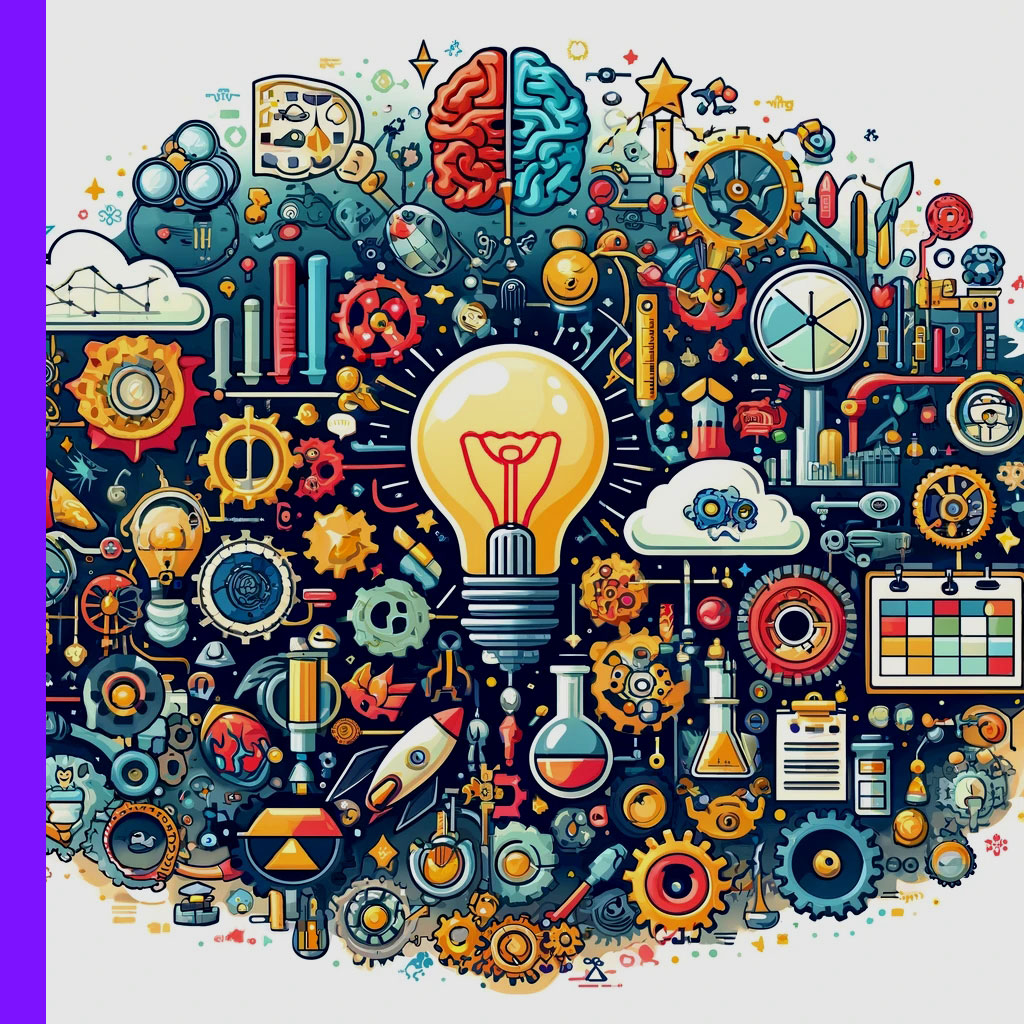
Innovation Tools
In the realm of innovation, a diverse array of tools is essential for fostering creativity, facilitating collaboration, and driving the successful implementation of new ideas. These tools span various stages of the innovation process, from ideation and research to prototyping, evaluation, and scaling.Here's an overview of key innovation tools categorized by their primary function:
Ideation and Creativity Tools
- SCAMPER: Seven thinking tools that help generate improvements in product, service and process.
- Inventing Thinking tools: Templates for generating innovations in product, problem solving and creative ads.
- Brainstorming Platforms: Miro and Stormboard enable remote teams to conduct collaborative brainstorming, capturing ideas visually in real-time.
- Nominal Group Technique: Structures group brainstorming to ensure everyone's contributions are heard.
- Mind Mapping Software: Tools like MindMeister and XMind assist in organizing and connecting thoughts, facilitating the development of new ideas.
Collaboration and Communication Tools
- Communication Platforms: Slack and Microsoft Teams enhance team communication and collaboration across projects.
- Project Management Software: Applications such as Trello, Asana, and Jira help in organizing and tracking innovation projects for better alignment and execution.
- Six Thinking Hats (by De Bono): Streamlines group discussions and individual thinking by exploring ideas from six distinct perspectives.
Research and Insight Tools
- Trend Analysis Platforms: Trend Hunter and CB Insights offer insights into market trends and emerging technologies, aiding in opportunity identification.
- Customer Feedback Tools: SurveyMonkey and UserVoice collect and analyze customer feedback to align innovations with user needs.
- Customer Interviews: Direct interactions with customers provide deep insights into their needs and preferences.
Prototyping and Testing Tools
- Prototyping Software: Adobe XD and Sketch support the design and prototyping of user interfaces, allowing for quick iterations.
- A/B Testing Platforms: Tools like Optimizely and VWO enable the testing of product versions to refine offerings based on user behavior.
- MVP (Minimum Viable Product): Facilitates the testing of new business ideas by releasing the most basic version of a product to gauge interest.
Evaluation and Decision-Making Tools
- Pugh Matrix: Helps select the best solution from alternatives using a decision matrix.
- Kano Model: Categorizes customer preferences to inform product development and satisfaction.
- Concept Testing: Employs methods to assess consumer response before market introduction.
- Innovation Matrix: Assesses the impact and feasibility of innovations.
- Decision Matrix Tools: Aid in evaluating and prioritizing ideas or projects based on various criteria.
Problem Solving Tools
- 10 Fold: Tackles significantly larger problems to find seamless solutions for the original issue.
- Backward Planning: Starts with the end goal and plans backward to identify necessary steps.
- Root Cause Analysis (RCA): Identifies the root causes of issues for effective problem-solving.
- 5 Whys & Fishbone Diagram (Ishikawa): Explore underlying problems and categorize potential causes.
- The Resolved Conflict Principle (TRIZ): Reconciles opposing objectives to achieve innovative outcomes.
Implementation and Scaling Tools
- Agile Development Tools: GitHub and GitLab support agile practices for rapid software iteration and scaling.
- Innovation Management Platforms: Brightidea and Planbox offer comprehensive solutions for managing the innovation lifecycle.
- Kanban Boards: Visual tools like Trello enhance project workflow optimization.
In conclusion, innovation tools play a pivotal role in navigating the complex landscape of bringing new ideas to fruition. From sparking creativity and fostering collaboration to streamlining implementation and scaling, these tools equip organizations with the necessary capabilities to not only generate innovative solutions but also to effectively bring them to market. By leveraging the right mix of tools across different stages of the innovation process, companies can enhance their agility, improve decision-making, and ultimately drive sustainable growth in an ever-evolving business environment.

Innovation Methods
Innovation methods serve as the backbone of the innovation process, providing structured frameworks that guide organizations from the spark of an idea to its realization in the market. These methods are essential for creating a systematic approach to innovation, ensuring that efforts are not just sporadic bursts of creativity, but part of a coherent strategy aimed at delivering sustainable value.
Following are some common methods used to enhanced and manage Innovation processes.
Common Innovation Methods
- Systematic Inventive Thinking (SIT): A method focusing on inside-the-box thinking, utilizing proven thinking tools, and existing resources and constraints to generate new ideas in product, problem solving and advertising.
- Lean Startup: Emphasizes rapid prototyping, testing, and iteration to bring products to market more quickly and efficiently.
- Stage-Gate Process: A project management technique that divides the innovation process into stages, separated by gates where decisions are made to continue or halt the project.
- Design Thinking: A human-centered approach to innovation that integrates the needs of people, the possibilities of technology, and the requirements for business success.
- Agile Development: An iterative approach to software development and project management that helps teams deliver value to their customers faster and with fewer headaches.
- Open Innovation: Leverages external and internal ideas and paths to market as organizations look to advance their technology and solutions.
- Blue Ocean Strategy: Encourages creating new market space or "Blue Ocean" making the competition irrelevant.
- Jobs to Be Done (JTBD): Focuses on understanding the customer's desire to "hire" a product or service to get a job done.
- TRIZ: A systematic approach to innovation that uses over 100 patterns of problem-solving from past inventions to address new challenges creatively.
The Importance of Innovation Methods
Innovation methods are crucial for several reasons, including:
- Structured Approach: They provide a structured approach to navigating the complex process of innovation.
- Risk Mitigation: By following a proven framework, organizations can reduce the inherent risks associated with innovation.
- Enhanced Creativity: These methods often encourage looking at problems and opportunities from new angles, enhancing creativity.
- Customer Focus: Many innovation methods emphasize understanding and meeting the needs of customers, ensuring that innovations are market-driven.
In conclusion, innovation methods are indispensable tools in the arsenal of any organization aiming to thrive in today’s fast-paced and competitive environment. By adopting and adapting these methods to their unique contexts, organizations can foster a culture of innovation that consistently generates value for customers and stakeholders alike.

Innovation Methods VS Innovation Tools
Innovation methods and innovation tools are both essential components of the innovation process, but they serve different purposes and operate at different levels of the innovation framework. Understanding the distinction between them is crucial for effectively managing and fostering innovation within an organization.
Innovation Methods
Innovation methods refer to the overarching approaches or methodologies that guide the innovation process. These methods provide a systematic framework for generating, developing, and implementing innovative ideas. They often encompass a set of principles, stages, and practices designed to foster creativity, encourage collaboration, and manage the development of new products, services, or processes.
Examples of innovation methods include:
- Design Thinking: A human-centered approach to innovation that integrates the needs of people, the possibilities of technology, and the requirements for business success.
- Lean Startup: A methodology that focuses on creating and managing startups and new ventures by developing a minimum viable product, measuring how it performs, and learning from the results.
- Open Innovation: An approach that emphasizes using external as well as internal ideas and paths to market as organizations look to advance their technology and innovations.
- Agile Innovation: An approach that applies agile development methodologies to the innovation process, emphasizing speed, flexibility, and customer feedback.
- Systematic Inventive Thinking (SIT): A method focusing on inside-the-box thinking, utilizing proven thinking tools, and existing resources and constraints, to generate new ideas in product, problem solving and advertising.
Innovation Tools
Innovation tools are specific techniques, software, or instruments used to support the activities and tasks within the innovation methods. These tools are more tactical and can be applied at various stages of the innovation process to help generate ideas, evaluate concepts, prototype solutions, or manage projects.
Examples of innovation tools include:
- SCAMPER: Seven thinking tools that help generate improvements in product, service and process, fast.
- Mind Mapping: A visual tool used to structure information, helping to better analyze, comprehend, synthesize, recall, and generate new ideas.
- Prototyping Software: Digital tools that allow for the rapid creation and iteration of product prototypes.
- Root Cause Analysis (RCA): Identifies the root causes of issues for effective problem-solving.
Key Differences
- Scope and Application: Innovation methods provide a holistic framework or philosophy for approaching innovation, while innovation tools are specific techniques or aids used within those frameworks.
- Purpose: Methods are about the "how" of innovation—how to approach the process of creating something new. Tools are about the "what"—what techniques or aids can be employed to support that process.
- Flexibility: Methods are generally more flexible and adaptable to different organizational contexts and goals. Tools, on the other hand, are often more concrete and may be used in specific tasks or stages of the innovation process.
In summary, innovation methods and tools are complementary elements of an effective innovation strategy. Methods offer the structured approaches needed to navigate the complexity of innovation, while tools provide the practical support needed to execute those approaches. Together, they enable organizations to systematically innovate and bring new ideas to fruition.
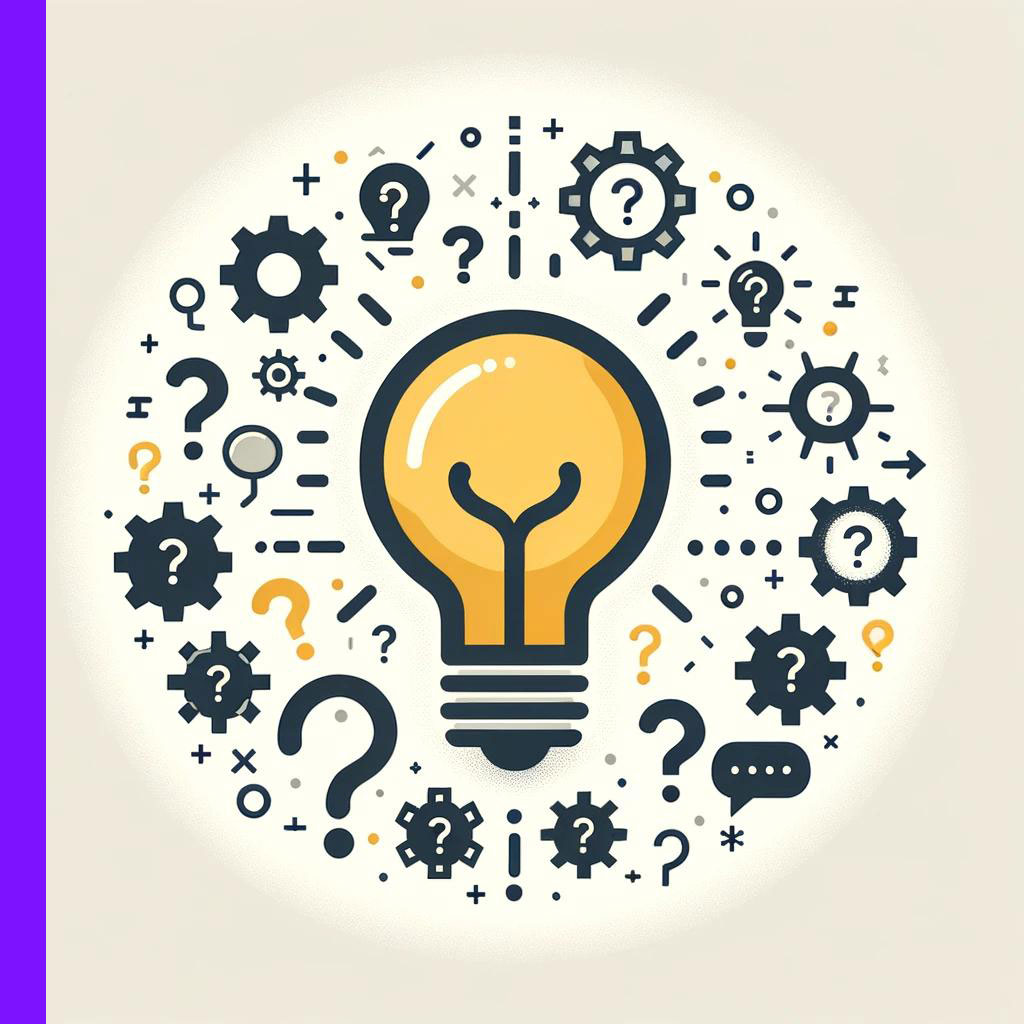
Brainstorming
Introduction to the Tool
Brainstorming stands as a pivotal technique in the realm of creative thinking and problem-solving. Originating from the advertising industry in the 1930s by Alex Osborn, its foundational premise is to foster an open and judgement-free environment where participants can freely share ideas, however unconventional they may be. The essence of brainstorming is the belief that quantity breeds quality in the idea generation process.
Who should use it
- Corporate teams across departments
- Creative agencies and design studios
- Academic researchers and educators
- Non-profit organizations for strategic planning
- Entrepreneurs and small business owners
When to Use
- During the initial phases of project development
- In need of creative solutions for problems
- For product or service innovation sessions
Objectives
- Stimulate creative thinking and idea flow
- Encourage team collaboration and participation
- Generate a wide range of solutions for a given challenge
- Foster an inclusive and open communication culture
How to Use It
 Clearly define the problem or question at hand.
Clearly define the problem or question at hand.- Assemble a diverse group of participants.
- Set the ground rules: no criticism and welcome all ideas.
- Begin the idea generation phase, encouraging free and open contributions.
- Record all ideas without evaluation.
- Encourage building on or combining ideas.
- Aim for quantity of ideas over quality, initially.
- Conclude the session and plan the evaluation of ideas.
Time Investment
- 30-60 minutes
Expected Results
- A broad spectrum of ideas, ranging from practical to innovative
- Enhanced team dynamics and creative confidence
- A selection of potential solutions to explore further
Benefits
- Unleashes collective creativity
- Levels the playing field for idea contribution
- Quick generation of a large number of ideas
- Encourages out-of-the-box thinking
Limitations
- Risk of quantity over quality
- Potential for groupthink or dominance by louder voices
- May require further sessions for idea refinement
- Not all (and often very few) ideas are feasible or relevant
- Predicts only 10% of all feasible future inventions
Examples
- A technology firm uses brainstorming to generate ideas for a new mobile application, leading to a unique user engagement feature.
- An environmental non-profit brainstorming session results in a novel fundraising campaign that significantly increases awareness and donations.
Conclusion
Brainstorming is a timeless and dynamic tool for idea generation, fostering an environment where creativity and innovation can flourish. By encouraging the contribution of all participants, it generates a wealth of ideas that can be the key to solving complex problems and discovering new opportunities. While it has its limitations, the benefits of enhanced creativity, team building, and problem-solving capabilities make it an essential technique in the arsenal of any team or organization aiming for innovation.
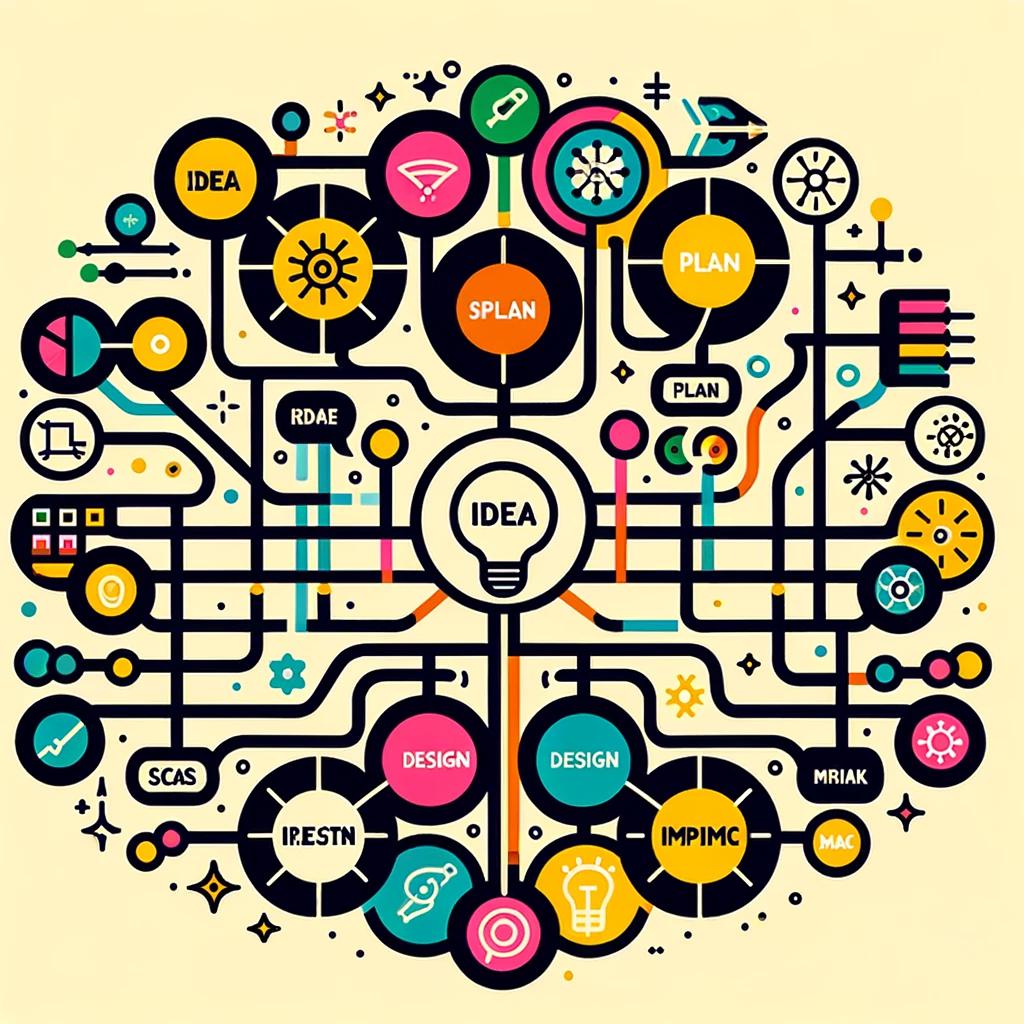
Mind Mapping
Introduction to the Tool
Mind Mapping is a visual tool for organizing information, widely attributed to Tony Buzan in the 1960s. It harnesses the full range of cortical skills—word, image, number, logic, rhythm, color, and spatial awareness—in a single, uniquely powerful manner. A mind map is hierarchical and shows relationships among pieces of the whole. It's designed to mirror the way the brain processes information.
Who should use it
- Students and educators for learning and teaching
- Project managers for planning and organization
- Creatives for brainstorming and idea development
- Business professionals for strategy development and decision-making
- Writers and researchers for structuring articles, papers, or reports
When to Use
- When organizing and structuring thoughts
- During study and revision for exams
- In planning projects or events
- While brainstorming for creative processes
- For problem-solving and decision-making
Objectives
- To visually organize information
- To facilitate learning and recall
- To enhance creative thinking and problem-solving
- To enable better planning and project management
- To integrate various types of information cohesively
How to Use It
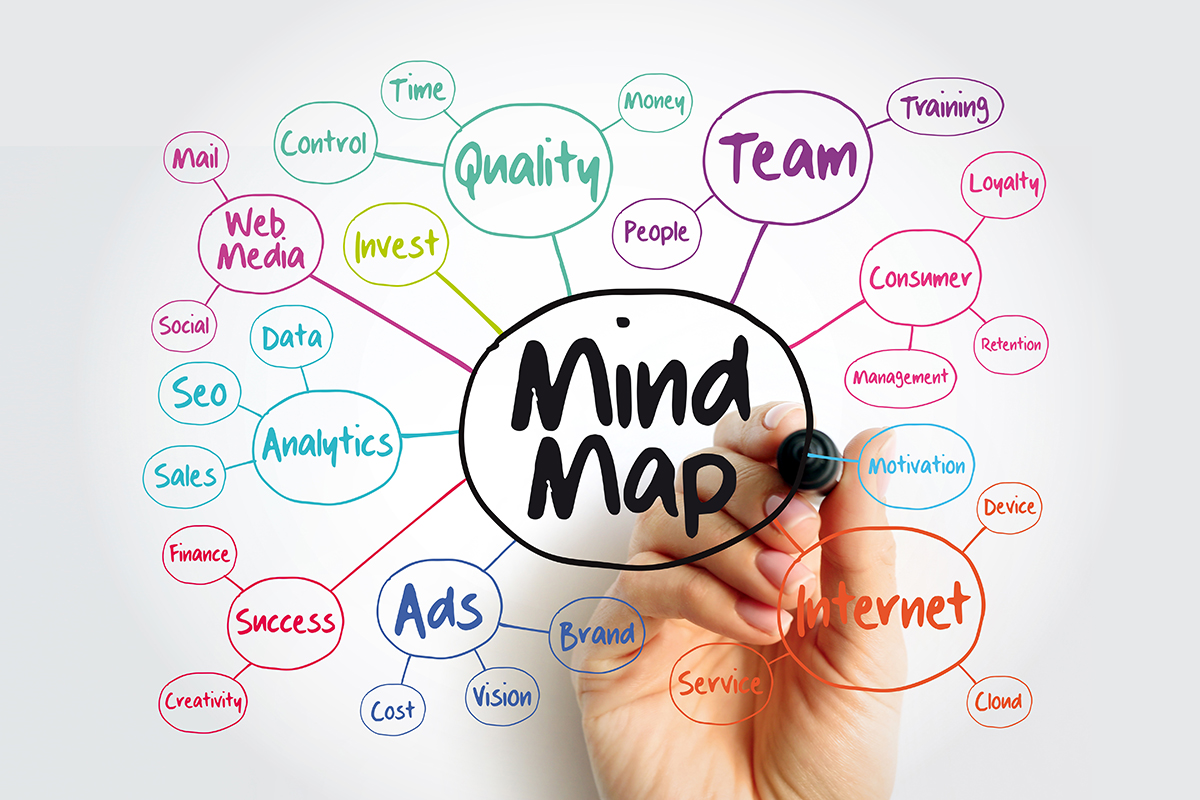 Start with a central idea or topic in the center of a blank page.
Start with a central idea or topic in the center of a blank page.- Create main branches radiating from the central idea.
- Add smaller branches to these main ones(details, related ideas).
- Use keywords and images to represent ideas succinctly.
- Employ colors and symbols to enhance memory and organize.
- Continue expanding with more branches as needed.
Time Investment
- 15-45 minutes
Expected Results
- A comprehensive visual representation of ideas and information
- Easier synthesis and understanding of complex subjects
- A structured approach to tackling tasks or learning material
Benefits
- Leverages visual-spatial awareness for information organization
- Simplifies complex ideas and structures
- Enhances memory and learning through association
- Encourages creative exploration of ideas
Limitations
- Can become cluttered if not organized well
- Not suitable for linear thinkers preferring detailed, sequential information
- May require practice to become efficient in mind mapping
Examples
- A student creates a mind map to outline a thesis, resulting in a well-organized and successful paper.
- A marketing team develops a mind map to brainstorm campaign ideas, leading to a clear strategy and innovative concepts.
Conclusion
Mind Mapping is an effective tool for organizing thoughts and ideas visually, making complex information simpler and more accessible. It fosters a creative and structured approach to learning, planning, and problem-solving. While it has limitations and may not suit every individual's thinking style, its flexibility and effectiveness in various scenarios make it a valuable technique in educational, personal, and professional contexts.
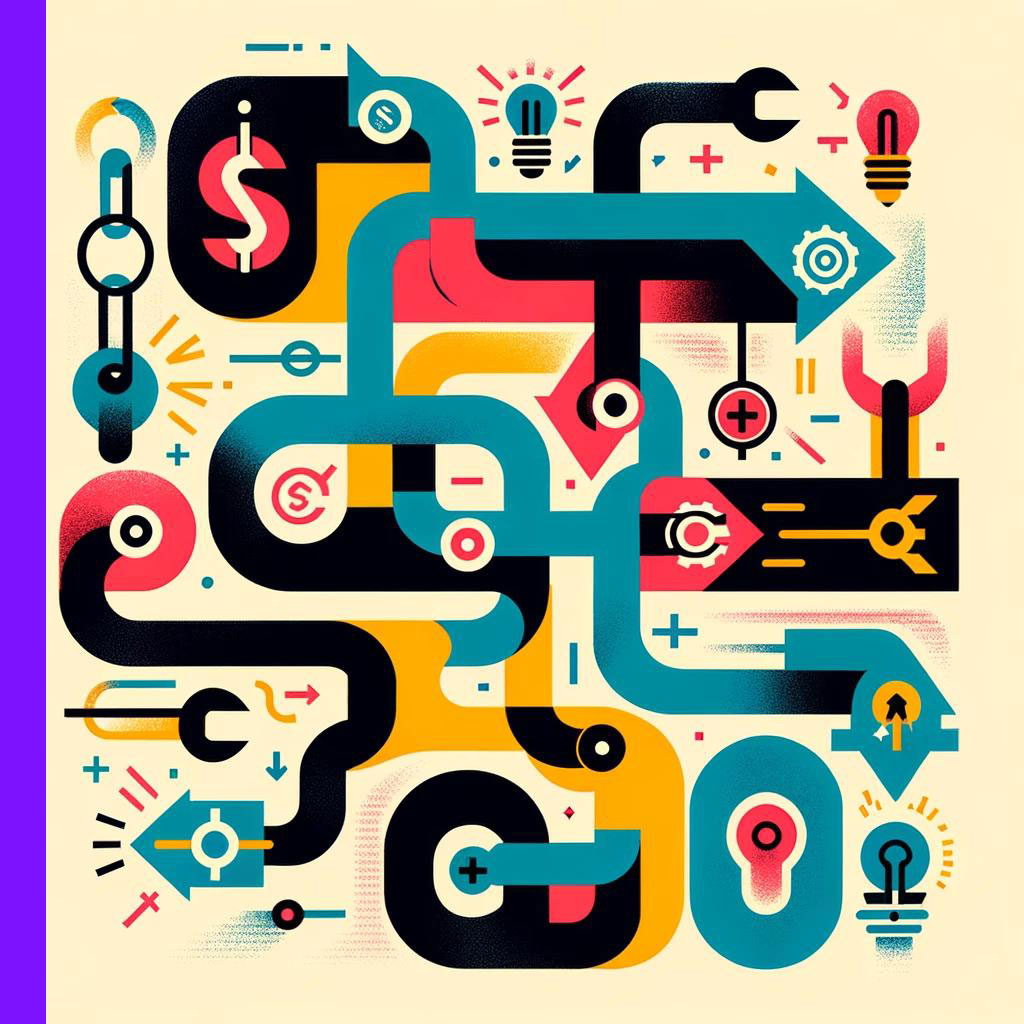
SCAMPER
Introduction to the Tool
SCAMPER is a creative thinking technique that guides users through iterative questioning, prompting new ideas. It is an acronym for Substitute, Combine, Adapt, Modify, Put to another use, Eliminate, and Reverse. Developed by Bob Eberle in the 1970s, it builds on Alex Osborn's brainstorming method and provides a structured way to think differently about products, services, or processes.
Who should use it
- Product designers and developers
- Business strategists and managers
- Marketing professionals
- Educators and students
- Entrepreneurs
When to Use
- For product or service innovation
- When seeking improvement in business processes
- During strategic planning sessions
- In educational settings for problem-solving activities
- For personal development to enhance creativity
Objectives
- To generate new ideas for existing products or services
- To improve or optimize business processes
- To overcome creative blocks
- To encourage out-of-the-box thinking
How to Use It
Click on the links below for detailed instructions
- Clearly identify the subject for improvement or innovation.
- Tip: Apply the Close World Analysis of this selected subject, to enhance the SCAMPER process that follows.
- Tip: Apply the Close World Analysis of this selected subject, to enhance the SCAMPER process that follows.
- Go through each SCAMPER letter and ask related questions:
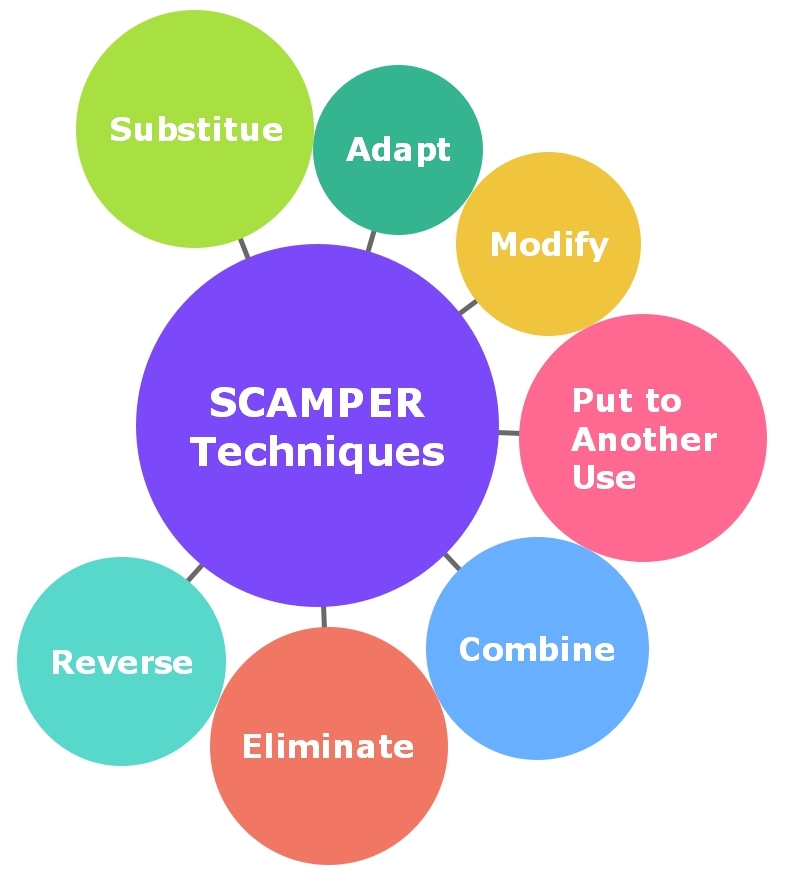
- Substitute: What elements can be replaced?
- Combine: How can we merge this with other objects or processes?
- Adjust: What ideas can we incorporate from other experiences?
- Modify: How can we change the shape, look, or feel?
- Put to other uses: How can we use this in another context?
- Eliminate: What can we remove without sacrificing value?
- Rearrange: Can we invert, re-arrange, or transpose processes or components?
- Record all ideas generated for later analysis and development.
Time Investment
- 20-60 minutes
Expected Results
- A list of innovative ideas
- Potential improvements to current offerings
- Fresh perspectives on existing challenges
Benefits
- Facilitates systematic creative thinking
- Encourages looking at problems from different angles
- Can lead to unique and innovative solutions
- Is adaptable to many contexts and problems
Limitations
- May not be suitable for all types of problems
- Predicts only 30% of all possible future inventions
- Requires open-minded participants
Examples
- A restaurant uses SCAMPER to redesign its menu, resulting in a more streamlined and customer-friendly layout.
- An automotive company applies SCAMPER to car design, leading to the development of a new, more efficient layout of the interior.
Conclusion
SCAMPER is a versatile and effective tool for innovation and problem-solving. It pushes the boundaries of conventional thinking and encourages exploration beyond the obvious. The technique's strength lies in its systematic approach, prompting users to rethink every aspect of a product, service, or process. While it has some limitations, the method's proven track record across various industries underlines its utility as a staple in the creative thinking toolkit.
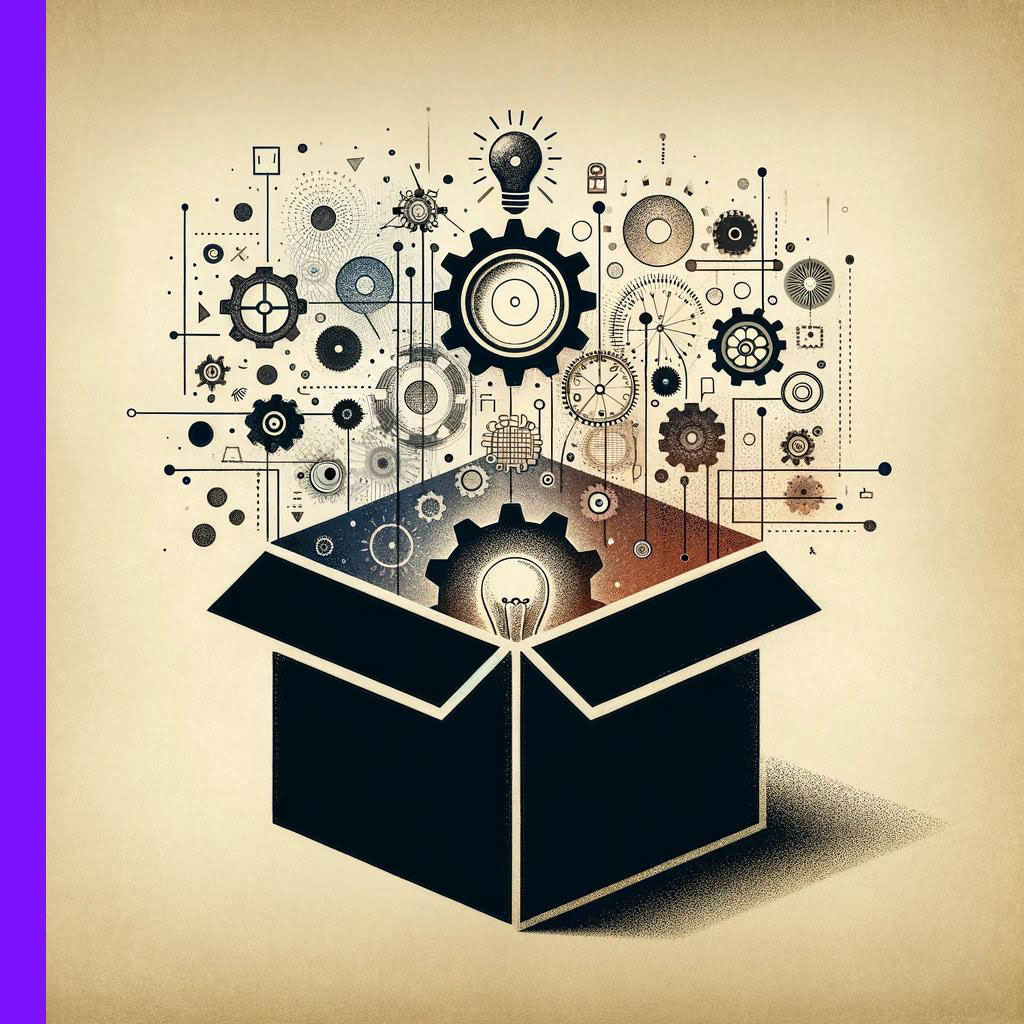
Systematic Inventing Thinking (SIT)
Introduction to the Methodology and Thinking Tools
Systematic Inventive Thinking (SIT) is a method that drives creative thinking by systematically imposing constraints to help innovators think inside the box. This counterintuitive approach was developed in the 1990s, building on Genrich Altshuller's Theory of Inventive Problem Solving (TRIZ). It's founded on the idea that limiting one's options can lead to more creative solutions.
Who should use it
- Product developers and engineers
- Marketing teams
- Business strategists and managers
- Educators and students in problem-solving curricula
- Entrepreneurs and startups
When to Use
- In the product development phase
- When seeking innovative solutions within constraints
- During strategic planning to overcome business challenges
- In educational settings to teach creative problem solving
Objectives
- To foster innovation within predefined constraints
- To solve problems using existing resources
- To streamline the product development process
- To enhance creative problem-solving skills
How to Use It
- Define the problem or challenge clearly.
- Identify existing resources and constraints:
- Perform Close World Analysis
- Perform Close World Analysis
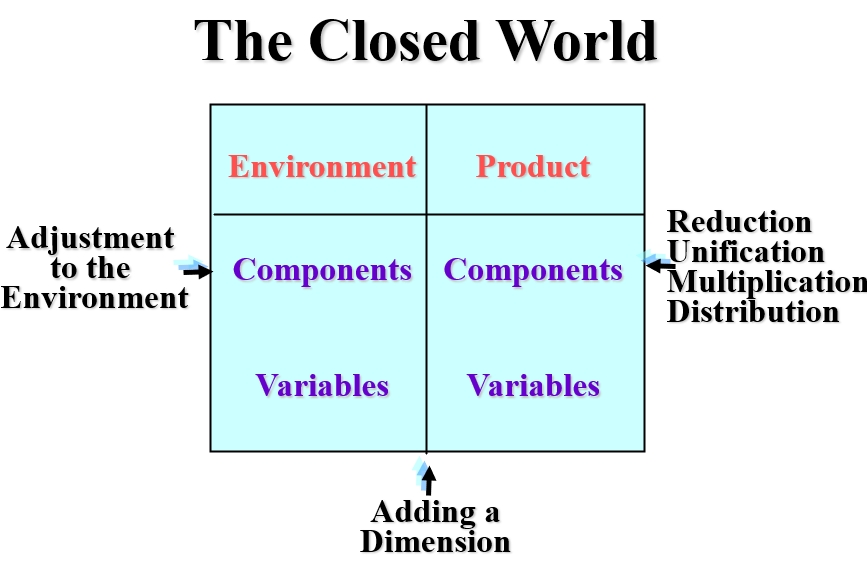 Apply SIT's six thinking tools:
Apply SIT's six thinking tools:
Follow the links for instructions- Adjustment to the Environment
- Multiplication
- Distribution (and/or Division)
- Subtraction (and/or Reduction)
- Unification
- Adding a Dimension (also called “Attribute Dependency”)
- Explore innovative solutions within the set constraints.
- Evaluate the ideas and refine them for practical implementation.
Note: Idea generation should ultimately be done in a multidisciplinary think tank of 8-12 people. This ensures good coverage of almost all possible innovations, while maintaining an efficient discussion.
Time Investment
- One day (for applying all 6 thinking tools by experienced SIT users)
- Three days (including time for learning the SIT tools and principles)
Expected Results
- Novel solutions that leverage existing resources
- Streamlined products or processes
- Enhanced problem-solving skills within constraints
Benefits
- Great coverage of valid solutions:
- Predicting 80% and more of all feasible product and service innovation ideas
- Outlining 50% and more of all feasible solutions to complex problems
- Encourages resourcefulness and ingenuity
- Breaks fixations and common cognitive biases
- Promotes cost-effective innovation
- Teaches a systematic approach to creativity
Limitations
- Requires a mindset shift to embrace constraints
- May be challenging for those accustomed to unrestricted brainstorming
- Requires 1 or more days of learning and practicing the method to become efficient user
Examples
- An ice cream manufacturer developed with us (ZOOZ consulting) dozens of innovative idea for new popsicles and ice-cream tubs, using SIT tools, leading to multiple successful, new products.
- CTS, a pharmaceutical company, turned a prescription drug into an OTC (over the counter medicine) medicine, applying the subtraction/reducing thinking tool in one of our Systematic Innovation workshops.
- Innovative functional suites for managers were developed by Bagir, using SIT methodology. Commercializing some of their inventions required them to apply SIT tools for technological problem solving as well.
Conclusion
SIT is an innovative tool that reshapes traditional thinking about creativity. It emphasizes that constraints can, paradoxically, free the mind to explore within set boundaries, leading to efficient and often groundbreaking solutions. While it presents a challenge to conventional idea generation, its structured approach makes it a powerful ally in the quest for innovation, and in predicting future inventions and overcoming challenging problems, systematically.
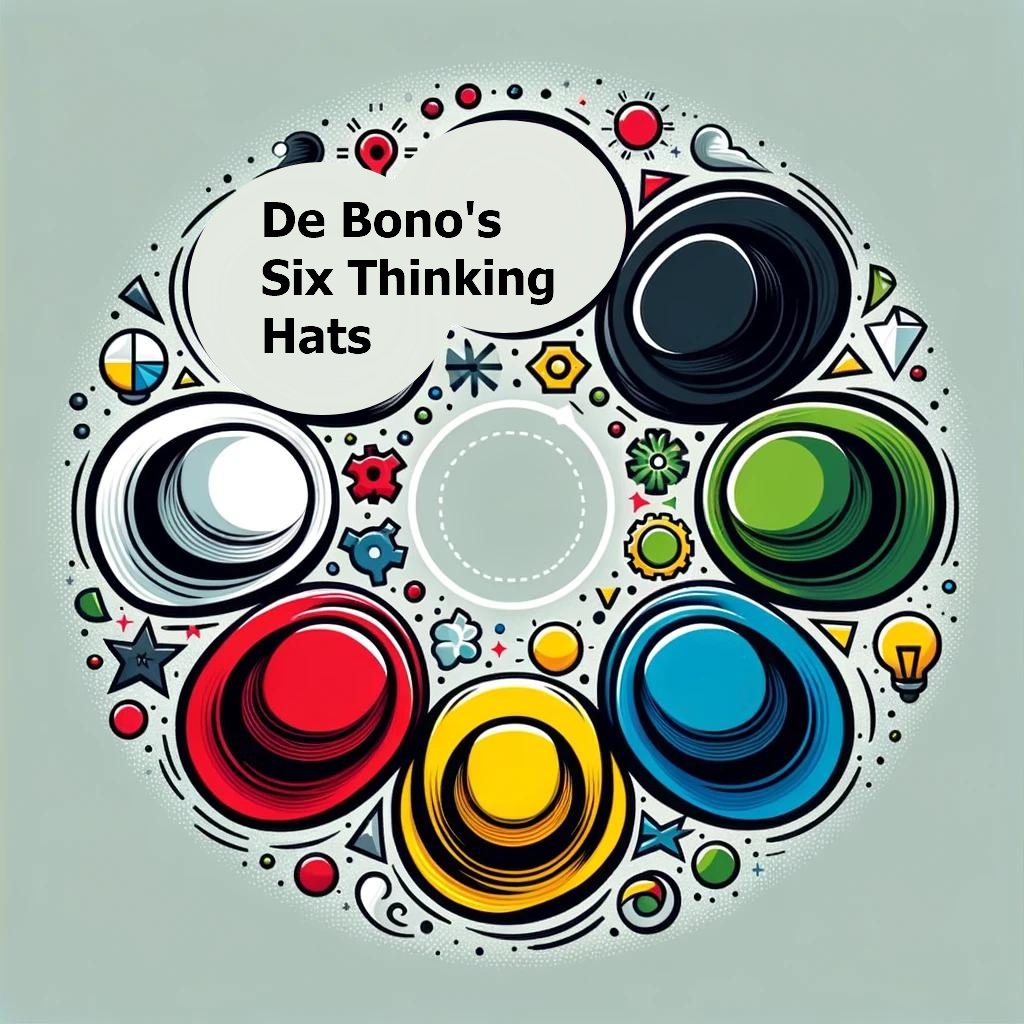
Six Thinking Hats (by De Bono)
Introduction to the Tool
The Six Thinking Hats is a problem-solving, in-depth discussion, and decision-making technique developed by Edward de Bono in the early 1980s. It involves six distinct types of thinking, each represented by a colored hat, to explore different perspectives towards a complex situation or challenge. This method encourages parallel thinking to ensure that all viewpoints are considered.
Who should use it
- Team leaders and managers
- Project teams
- Educators and trainers
- Creative professionals
- Decision-making groups
When to Use
- When solving complex problems requiring varied perspectives
- During ideation sessions to generate diverse ideas
- In meetings to structure discussion and decision-making
- To enhance collaboration and communication within teams
Objectives
- To facilitate comprehensive exploration of issues from multiple angles
- To improve the quality of decision-making
- To reduce conflict among team members by structuring communication
- To encourage creative and critical thinking
How to Use It
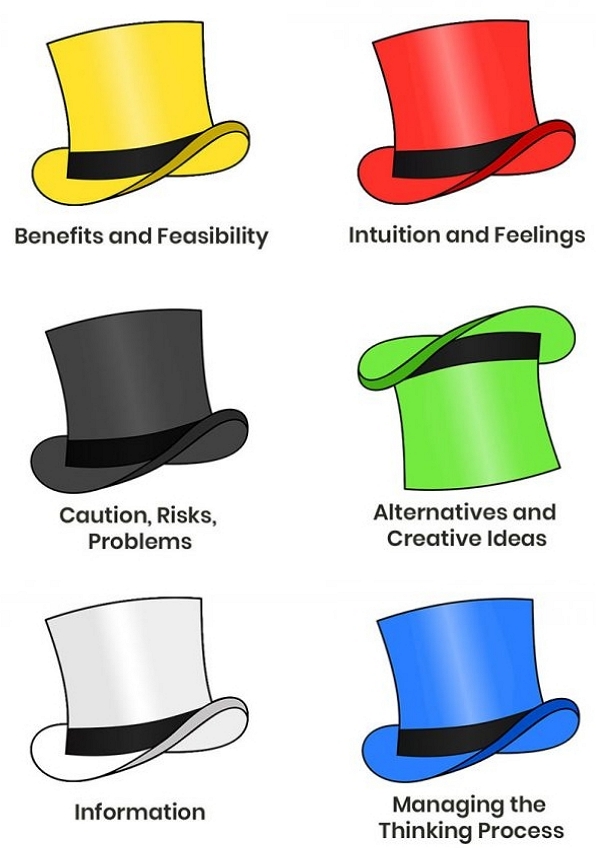 Red Hat: Look at solutions using intuition, gut reaction, and emotion.
Red Hat: Look at solutions using intuition, gut reaction, and emotion.
- Tip: Initiate discussions with the Red Hat to share and neutralize strong feelings by participants.
- Tip: Initiate discussions with the Red Hat to share and neutralize strong feelings by participants.
- Yellow Hat: Think optimistically and explore the value and benefits.
- Tip: Use the Yellow Hat early to evoke a sense of value and importance in the discussion.
- Tip: Use the Yellow Hat early to evoke a sense of value and importance in the discussion.
- White Hat: Focus on data and information available.
- Black Hat: Consider the difficulties and potential problems.
- Green Hat: Foster creativity and suggest new ideas.
- Tip: Use cycles of Black Hat (problems) and Green Hat (creative solutions) to encourage resourcefulness. Creative solutions tend to create some problems, which further Green thinking can solve.
- Tip: Use cycles of Black Hat (problems) and Green Hat (creative solutions) to encourage resourcefulness. Creative solutions tend to create some problems, which further Green thinking can solve.
- Blue Hat: Manage the thinking process and ensure each hat is utilized, also – manage decision making.
- Tip: Before decision-making, use the Red Hat again to map emotions (that influence decision making).
Time Investment
- 60-90 minutes
Expected Results
- A well-rounded understanding of the problem or the solution
- Comprehensive development of creative solutions and strategies
- Enhanced team collaboration and respect for diverse perspectives
Benefits
- Encourages parallel thinking and minimizes confrontational debate
- Facilitates more structured and thorough discussions
- Enhances problem-solving and decision-making processes
- Promotes the sharing of emotions and feelings in an organizational setup
- Note: When emotions are revealed and considered, decision-making improves
Limitations
- May require practice to be used effectively
- The success of the technique depends on the participants' willingness to engage
- Might be challenging for teams not accustomed to structured discussion formats
- Does not necessarily enhance creativity
- Note: the Green Hat allocates time for creativity, but does not explain how to become creative
Examples
- A management team uses the Six Thinking Hats to discuss a disruptive business strategy.
- A product development team applies the Six Thinking Hats to solve product design issues and elaborate on chosen solutions.
Conclusion
The Six Thinking Hats technique offers a unique and effective framework for enhancing team discussions, decision-making, and problem-solving. By structuring the way individuals think about challenges, it encourages diversity of thought, reduces conflict, and leads to more innovative solutions.
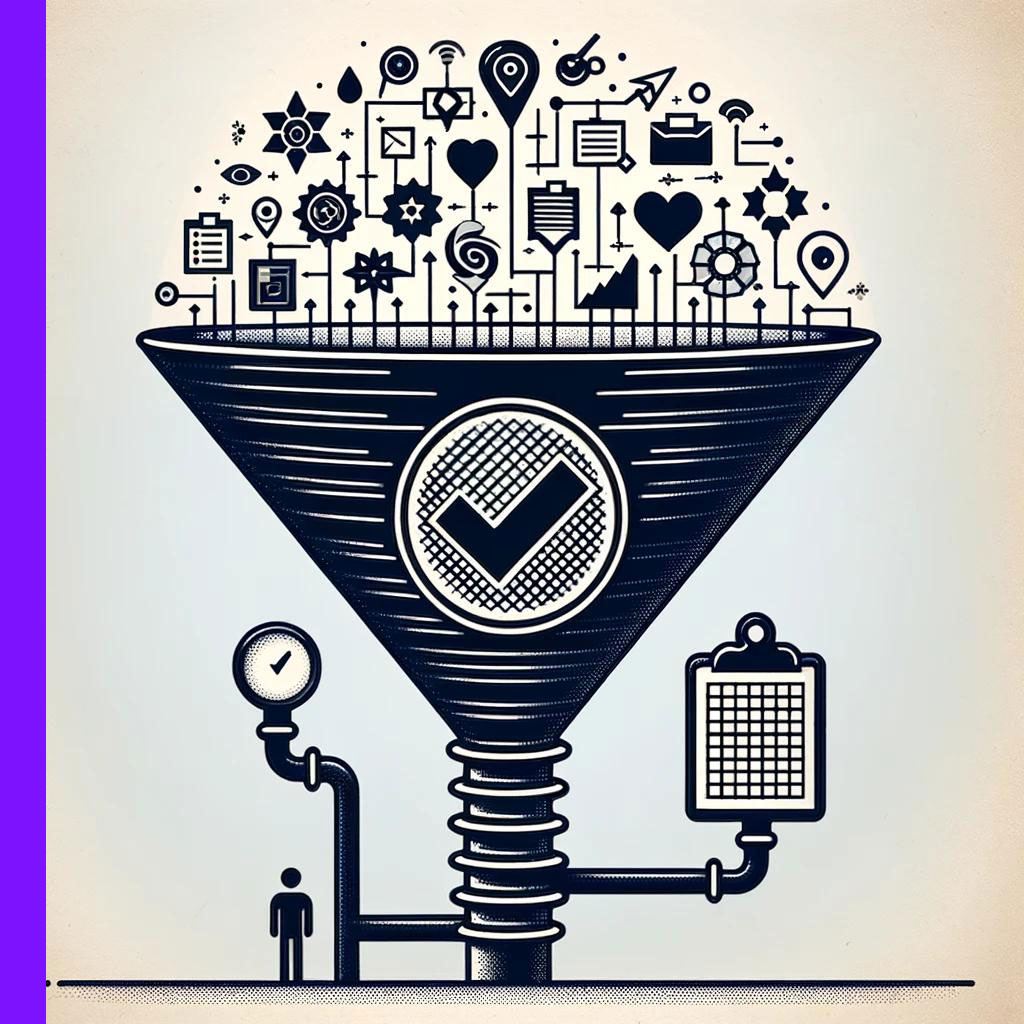
Internal Screening
Introduction to the Tool
Internal screening is a business strategy tool used to evaluate a company's ideas and projects against a set of predetermined criteria to determine their potential for success. Its origin lies in strategic management principles, focusing on maximizing the use of internal resources and capabilities to achieve competitive advantage.
Who should use it
- Corporate strategists and decision-makers
- Project managers
- Innovation teams
- R&D departments
- Startup founders
When to Use
- During the idea generation phase of product development
- When managing an Idea Bank
- Before committing resources to a project
- When prioritizing multiple projects or ideas
- In the annual planning cycle
Objectives
- To identify the most promising projects or ideas
- To allocate resources efficiently
- To minimize investment in non-viable projects
- To streamline the innovation pipeline
How to Use It
- Establish clear criteria for project evaluation.
- For example: feasibility, ROI, strategic fit, novelty
- For example: feasibility, ROI, strategic fit, novelty
- Collect a list of all ideas and projects to be screened.
- Score each project against the criteria.
- Rank the projects based on their scores.
For example, see the following table: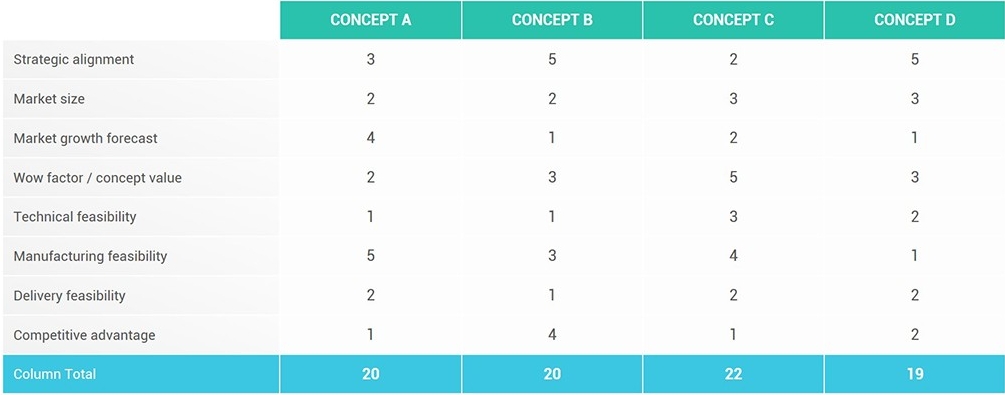
- Select the highest-ranking projects for further development.
Time Investment
- 2-4 hours
Expected Results
- A prioritized list of projects
- Better alignment of projects with strategic goals
- More effective resource allocation
Benefits
- Systematic approach to project evaluation
- Objective decision-making
- Enhanced project success rates
- Improved strategic focus
Limitations
- May overlook the potential of unconventional ideas
- Dependent on the quality of the screening criteria
- Can be time-consuming if not well-managed
Examples
- A tech company uses internal screening to select the most promising app concepts from a pool of ideas.
- A pharmaceutical firm applies internal screening to focus its R&D efforts on the drugs most likely to succeed in clinical trials.
Conclusion
Internal screening is an essential tool for organizations aiming to optimize their innovation processes. By systematically evaluating ideas against strategic criteria, companies can focus their efforts on the projects with the highest potential for success. While it requires careful planning and implementation, the benefits of informed decision-making and efficient resource allocation make it a valuable tool in the business arsenal.
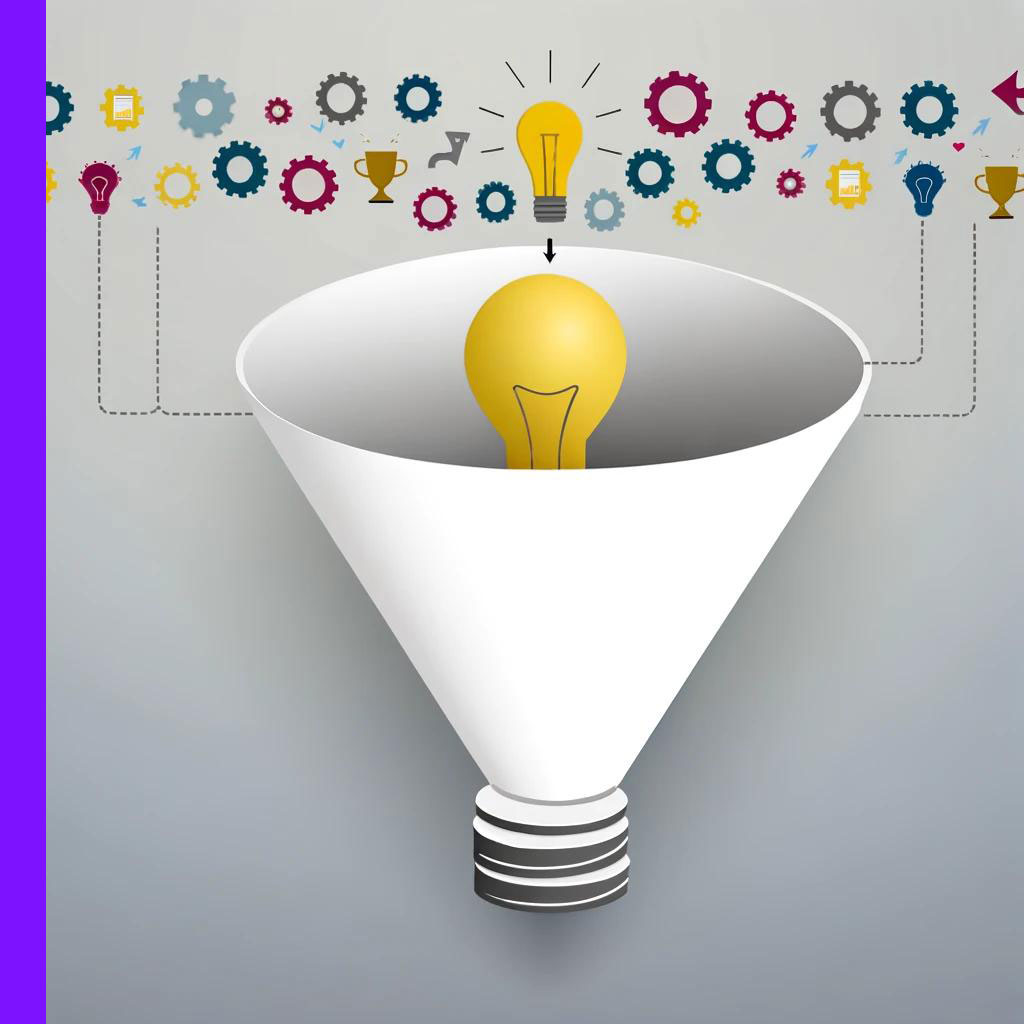
Idea Funnel
Introduction to the Tool
The idea funnel is a metaphorical concept used in business and innovation to represent the process of filtering numerous ideas to select the few that are viable for implementation. It mirrors the shape of a physical funnel, wide at the entry point for the generation of many ideas and narrowing towards the bottom where ideas are evaluated and refined.
Who should use it
- Business executives and managers
- Innovation and R&D teams
- Startups and entrepreneurs
- Marketing professionals
- Product managers
When to Use
- During the ideation phase of product development
- In strategic planning sessions
- When prioritizing innovation initiatives
- For campaign development in marketing
Objectives
- To manage the flow of ideas efficiently
- To prioritize ideas based on potential impact
- To streamline the decision-making process
- To allocate resources to the most promising ideas
How to Use It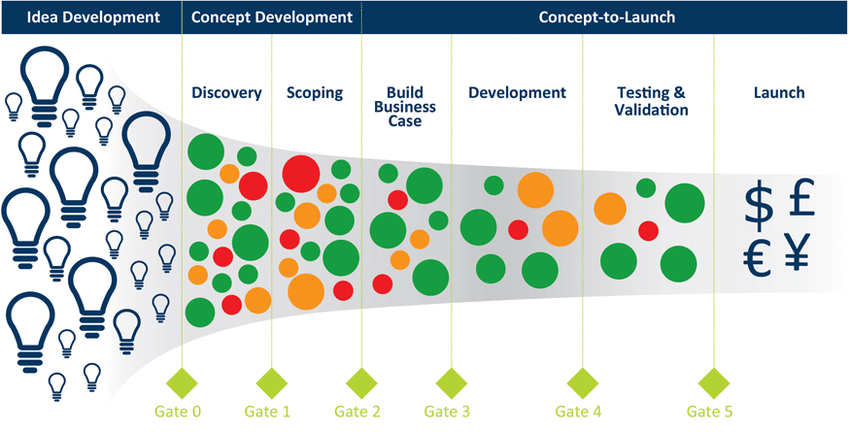
- Generate a wide range of ideas.
- Set initial filtering criteria based on strategic alignment and feasibility.
- Narrow down the ideas through successive stages of evaluation.
- Apply more specific criteria at each stage to further refine the selection.
- End with a shortlist of actionable ideas ready for development or testing.
Time Investment
- 1-3 hours
Expected Results
- Sorted and prioritized Idea Bank
- A manageable list of actionable ideas
- Increased focus on high-quality and strategic initiatives
- Improved alignment of ideas with business goals
Benefits
- Encourages broad thinking followed by strategic focus
- Efficiently narrows down options, saving time and resources
- Systematic approach to innovation
Limitations
- Dependent on the quality of the filtering criteria
- Can be biased by the facilitator's perspective
- May inadvertently filter out unconventional yet valuable ideas
Examples
- A consumer goods company uses an idea funnel to decide on new product lines.
- A digital agency employs the funnel to determine which marketing strategies to implement for a high-profile campaign.
Conclusion
The idea funnel is a practical and effective tool for distilling a multitude of ideas into a select few that are worth pursuing. It provides a structured approach to innovation, ensuring that only the most promising ideas receive the scarce and valuable resources required to bring them to life. This tool is instrumental for organizations that want to foster a disciplined yet creative approach to innovation.
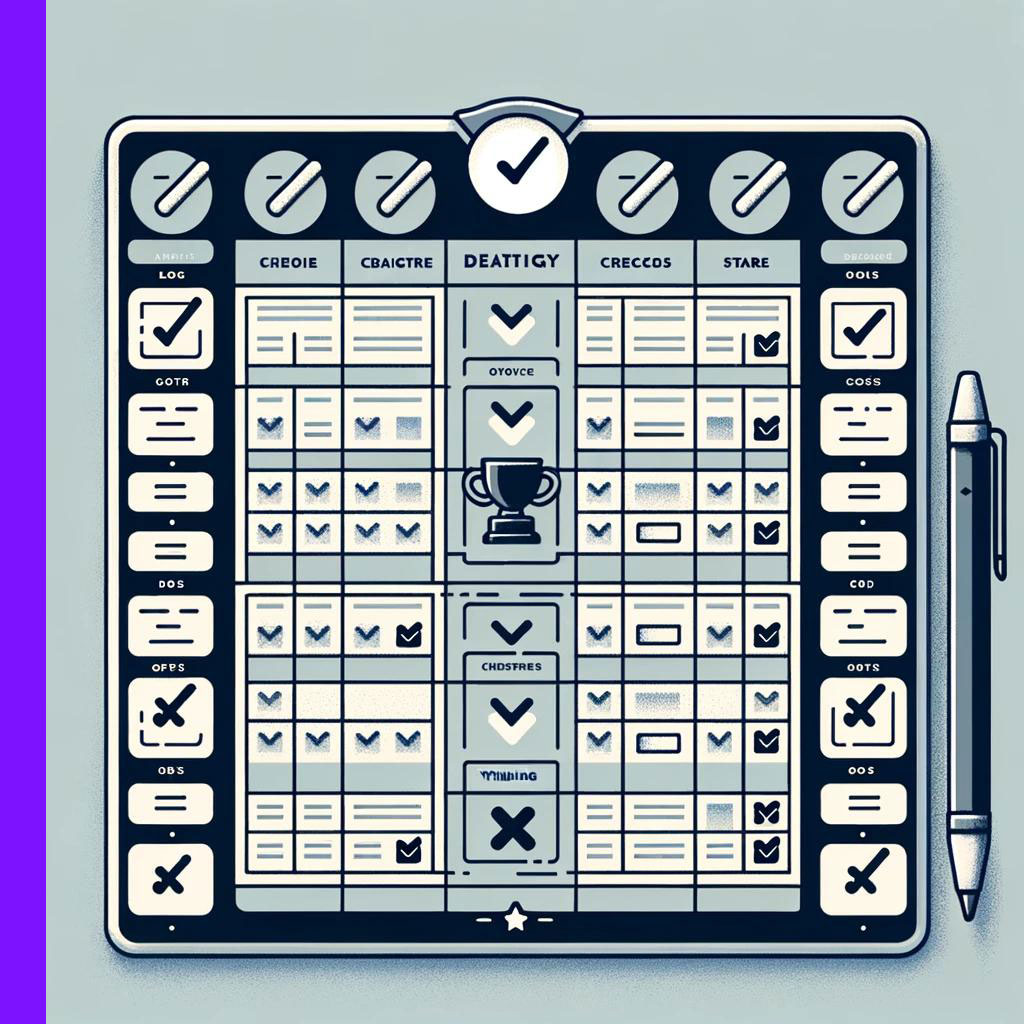
Pugh Matrix
Introduction to the Tool
The Pugh Matrix, also known as the Pugh Method or decision matrix, is a quantitative technique used to rank the multi-dimensional options of an operational product or process. Developed by Stuart Pugh, it is a fundamental tool for concept selection that involves evaluating various alternatives against a set of weighted criteria.
Who should use it
- Design engineers
- Product managers
- Business analysts
- Quality assurance teams
- Strategic decision-makers
When to Use
- When comparing the relative merits of multiple options
- In the concept development phase of a product or process
- During strategic business decisions
- For resource allocation and investment decisions
Objectives
- To facilitate objective decision-making
- To compare different solutions or concepts fairly
- To help identify the strongest candidate among a set of options
How to Use It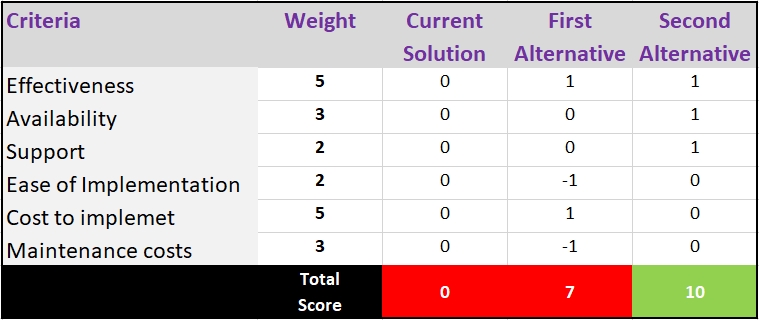
- Define the criteria for decision-making.
- Assign weight to each criterion based on importance.
- List all the alternatives to be compared.
- Score each alternative against each criterion.
- Multiply the score by the weights to get a weighted score.
- Sum weighted scores to get a total score for each alternative.
- Rank the alternatives based on the total score.
Time Investment
- 1-3 hours
Expected Results
- A ranked list of options or solutions
- Clear understanding of the strengths and weaknesses of each option
- An informed basis for making decision
Benefits
- Provides a structured approach to decision-making
- Encourages comprehensive evaluation of options
- Helps to quantify subjective opinions
Limitations
- Relies on the accurate weighting of criteria
- Can be overly simplistic for very complex decisions
- Subject to bias in criteria selection and weighting
Examples
- A manufacturing company uses the Pugh Matrix to decide on new equipment purchases.
- A software development team employs the Pugh Matrix to select features for the next product release.
Conclusion
The Pugh Matrix is a versatile and straightforward tool that aids in the decision-making process by providing a systematic approach to evaluating multiple options. It is most effective when the criteria for decision-making are well-understood, and the alternatives can be fairly compared against these criteria. While there are limitations to its simplicity and potential for bias, the Pugh Matrix remains a popular method for its ease of use and clarity it brings to complex decisions.

Nominal Group Technique
Introduction to the Tool
The Nominal Group Technique (NGT) is a structured method for group brainstorming that encourages contributions from everyone in the group. Developed by Delbecq and Van de Ven in the 1960s, it is designed to enhance group decision-making by ensuring that all members have an equal voice.
Who should use it
- Business teams at all levels
- Project management groups
- Workshop facilitators
- Organizational development consultants
- Academic researchers and educators
When to Use
- When making decisions that require input from a variety of stakeholders
- In situations where some group members may be less vocal
- To avoid dominance of the group by a single person or a few individuals
- When generating a wide range of ideas is important
Objectives
- To gather a broad spectrum of ideas from all group members
- To ensure that each participant has an equal voice
- To prioritize ideas or solutions based on group consensus

How to Use It
- Introduce the issue and give everyone a few minutes to generate ideas independently.
- Go round-robin in the group, allowing each person to present one idea until all ideas are shared.
- Discuss the ideas as a group to clarify and evaluate them.
- Each group member silently and independently votes on the ideas.
- Tally the votes and rank the ideas according to the group’s preference.
Time Investment
- 30-60 minutes
Expected Results
- A ranked list of ideas reflecting the group’s preferences
- Enhanced participation from all group members
- A sense of fairness and democratic decision-making
Benefits
- Encourages equal participation
- Reduces the influence of group pressure and hierarchy
- Can be completed in a relatively short period
Limitations
- May not be suitable for complex problems requiring in-depth discussion
- Can limit the development of ideas due to independent and silent voting
- The process may suppress spontaneous interaction
Examples
- A marketing team uses NGT to prioritize customer outreach strategies.
- An HR department employs NGT to select employee wellness program activities.
Conclusion
The Nominal Group Technique is a valuable tool for decision-making and idea generation within groups. It levels the playing field by allowing silent members to have their say, thereby democratizing the process and improving the diversity of thoughts. While it may not be the best fit for all decision-making scenarios, its structured approach makes it a beneficial technique in many situations.
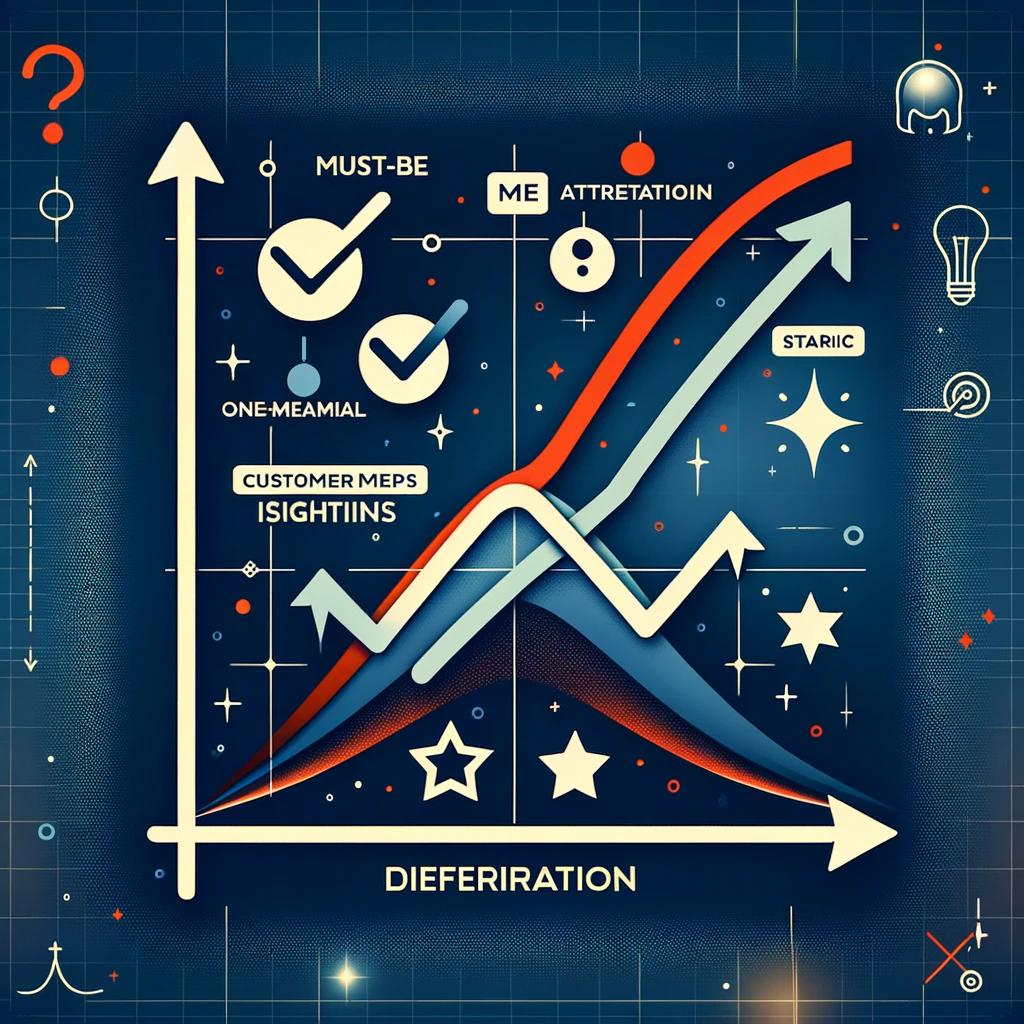
Kano Model
Introduction to the Tool
The Kano Model is an analytical technique for product development and customer satisfaction developed by Professor Noriaki Kano in the 1980s. It categorizes customer preferences into five categories: Must-Be, One-Dimensional, Attractive, Indifferent, and Reverse, helping to prioritize features based on customer impact.
Who should use it
- Product managers
- UX/UI designers
- Marketers
- Customer experience strategists
- Business development professionals
When to Use
- In the product design phase to determine features
- During market analysis for understanding customer needs
- When evaluating potential improvements to products or services
- For strategic decision-making in creating a product roadmap
Objectives
- To identify and prioritize features that increase customer satisfaction
- To differentiate between essential and enhancing product qualities
- To allocate resources effectively to features that will impact satisfaction
How to Use It
- Survey at least 20-30 customers to gather data on their preferences for various features.
For each given feature you want to test, ask about the presence and absence of the feature:
(A) How would you feel if you had [this feature]?
i. I like it.
ii. I expect it.
viii. I am neutral.
iv. I can tolerate it.
v. I dislike it.
(B) How would you feel if you did not have [this feature]?
i. I like it.
ii. I expect it.
iii. I am neutral.
iv. I can tolerate it.
v. I dislike it. - Categorize the features into Kano’s five categories based on customer responses:
Kano’s Five Emotional Response Types
a. Must-be Features: Basic expectations; absence causes dissatisfaction.
b. Performance Features: Enhance satisfaction as quality improves.
c. Attractive Features: Unexpected; significantly boost satisfaction.
d. Indifferent Features: No impact on satisfaction.
e. Reverse Features: Cause dissatisfaction when present.
- The Five Emotional Response Types are derived as follows:
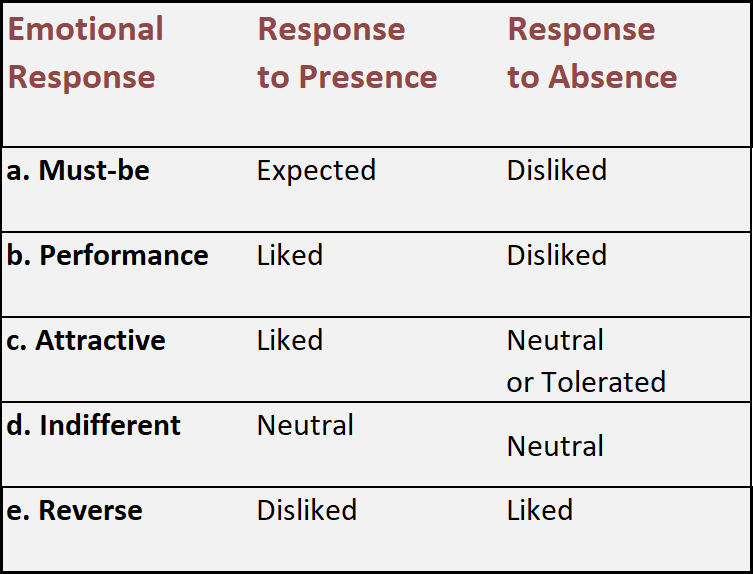
- The Five Emotional Response Types are derived as follows:
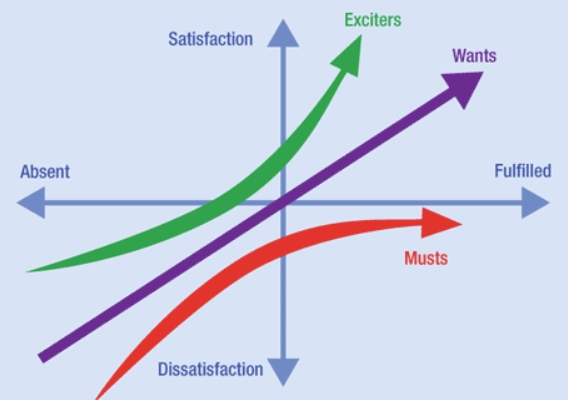 Analyze the results to determine which features are most likely to satisfy customers.
Analyze the results to determine which features are most likely to satisfy customers.- Prioritize the development of features based on their potential impact on satisfaction.
- Continually update and reassess features as customer preferences change.
Time Investment
- 2-8 hours for survey and analysis
Expected Results
- Clear categorization of product features
- Prioritized list of features for development
- Insights into customer satisfaction drivers
Benefits
- Provides a user-centered approach to product development
- Helps in understanding customer needs and desires
- Aids in creating a feature-rich product that aligns with customer satisfaction
Limitations
- May require a large and diverse sample size for accurate categorization (100-200 responders)
- Customer preferences can change over time, requiring regular reassessment
- The model does not account for the cost of implementing features
Examples
- A software company uses the Kano Model to prioritize new features for an app update.
- An automotive company applies the Kano Model to design enhancements for the next model year.
Conclusion
The Kano Model is an insightful tool for aligning product development with customer satisfaction. It offers a structured method for evaluating the impact of different features and can guide strategic decisions in product design. While there are limitations, particularly concerning the dynamic nature of customer preferences, the model's focus on customer satisfaction makes it an invaluable asset in the competitive landscape of product development.
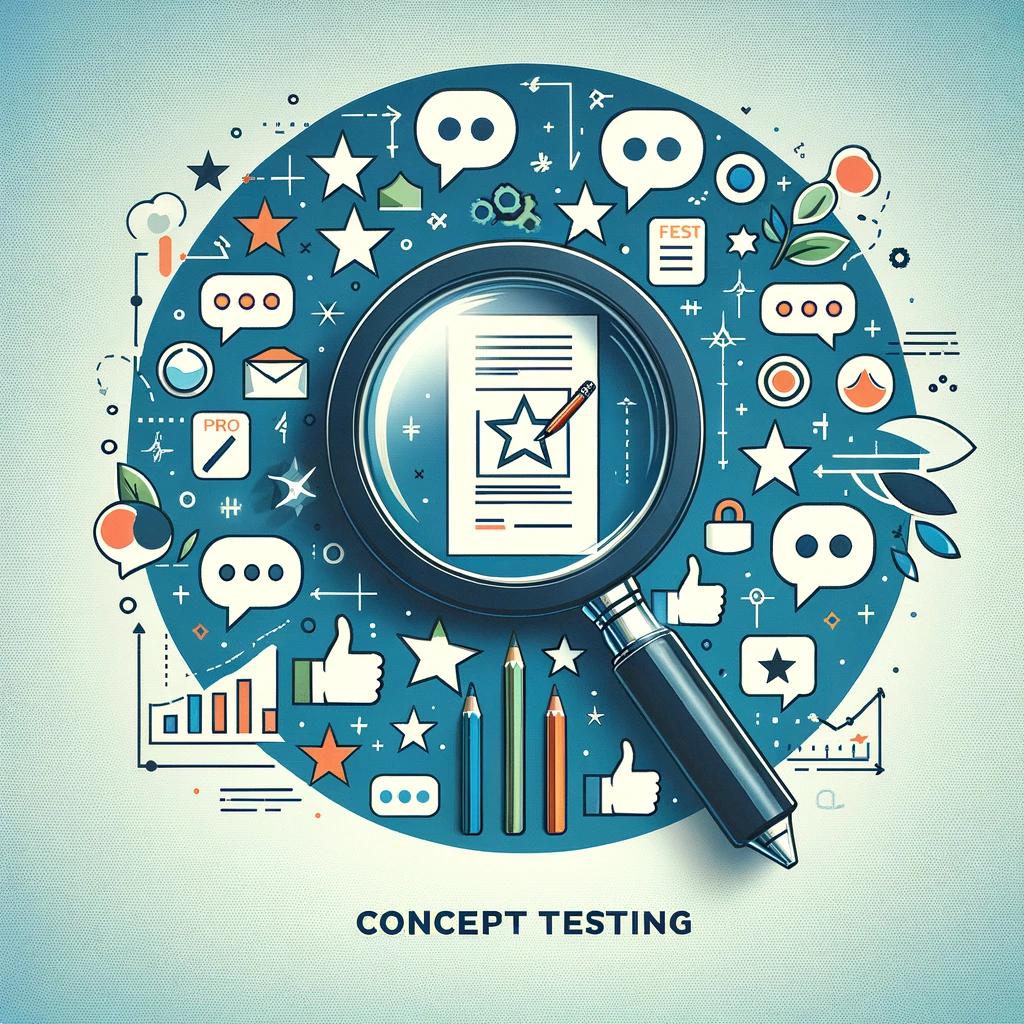
Concept Testing
Introduction to the Tool
Concept testing is a process used to evaluate consumer response to a product idea before it is introduced to the market, or even created. This method allows businesses to gauge potential customer interest and make modifications before committing significant resources to production.
Who should use it
- Product developers
- Marketing teams
- Business strategists
- Entrepreneurs
- Research and development specialists
When to Use
- Before product development begins
- After initial idea generation but before market launch
- When considering product adjustments based on feedback
- During early stages of business planning
Objectives
- To validate the appeal of a product concept among potential customers
- To refine product features based on consumer feedback
- To forecast future sales and profitability
- To reduce the risk of product failure post-launch
 How to Use It
How to Use It
Click on the links below for detailed instructions
- Develop a thorough concept description or prototype.
- Select your target audience.
- Choose the appropriate method for concept testing (surveys, focus groups, etc.).
- Collect and analyze consumer feedback.
- Make informed decisions on product development or modification.
- Monitor real-world results of launched concepts, and compare them to the survey results, in order to calibrate the testing. This way, you will be able to accurately predict how will future concepts perform in the market.
Note: In order to accurately compare results of various concepts, it is crucial to keep a uniform structure, content and format for all concepts, and to always use the same questionnaire. For example, if the concept mentions your brand name, mention it in all future concepts. And if it does not – never mention it in any future concept.
Time Investment
- Varies, typically 1 day per concept
(for phrasing, surveying 20-30 people, gathering results, analysing, and discussing the results)
Expected Results
- Insightful consumer feedback on the product concept
- Data-driven decisions for product innovation
- Enhanced likelihood of market success
Benefits
- Lowers risk and cost of product failures.
- Clarifies consumer needs and preferences.
- Boosts product development speed and efficiency.
- More cost-effective and informative than focus groups, while reducing bias.
- Yields both qualitative and quantitative insights.
- Enables accurate sales forecasts through calibrated (real-world) quantitative data.
Limitations
- May not fully capture the product's potential in a real-world environment.
- Calibrating previous tests against real-world results can enhance accuracy.
- Results can be influenced by how the concept is presented.
- Consistent testing methods and execution help mitigate this bias.
- For example, having the same individual conduct all surveys across various concepts can be beneficial.
- May require investment in multiple rounds of testing for thorough feedback
Examples
- A tech company tests consumer reaction to a new app concept.
- A food company uses concept testing to evaluate packaging options.
Conclusion
Concept testing is a critical step in the product development process, offering valuable insights that can lead to a more successful product launch. By engaging with potential customers early on, businesses can tailor their products to better meet consumer needs and reduce the risk of market failure. It's a strategic investment that can pay dividends in the form of a more aligned product-market fit.
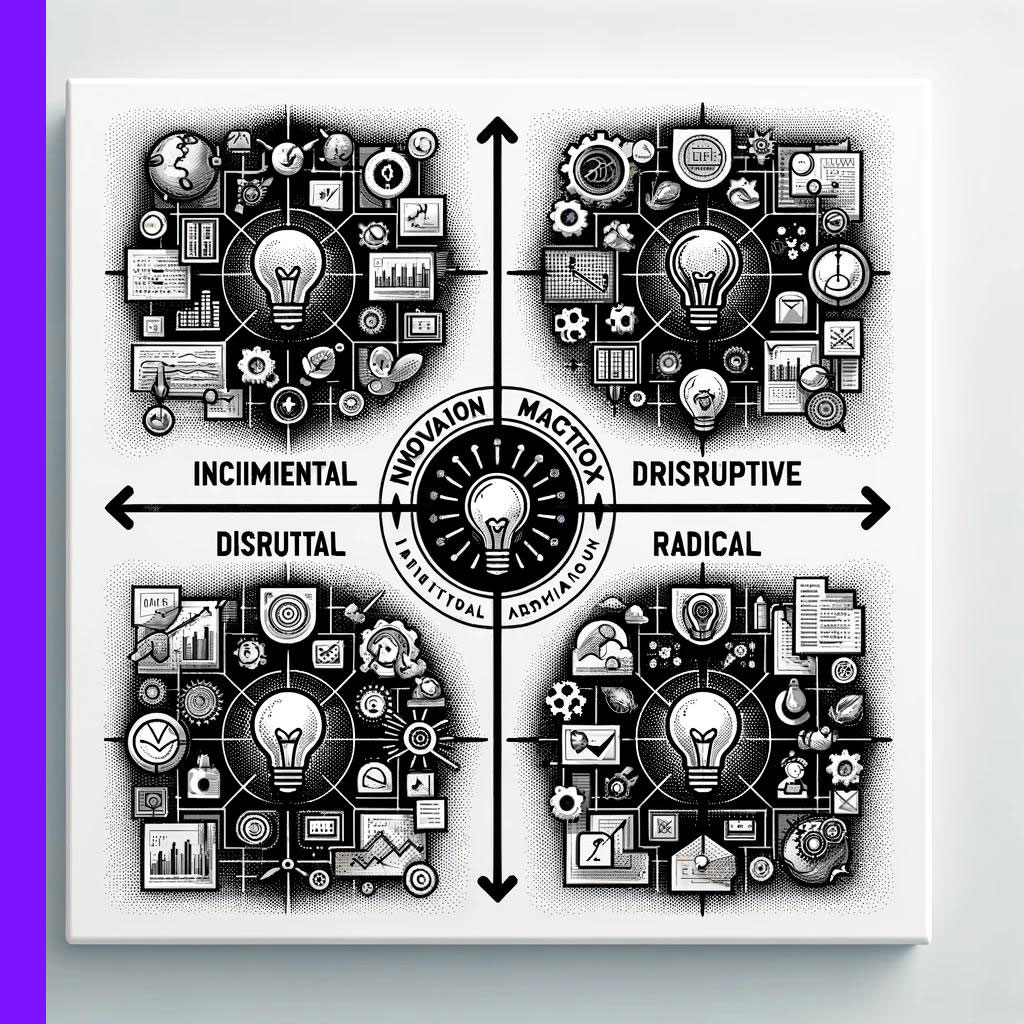
Innovation Matrix
Introduction to the Tool
The Innovation Matrix is a strategic tool used to categorize and assess different types of innovation based on two dimensions: technology novelty and market novelty. It aids in understanding the risk profile and strategic approach required for different innovation types, from incremental improvements to radical innovations.
Who should use it
- Corporate strategists
- R&D managers
- Product development teams
- Business development executives
- Entrepreneurs and startup founders
When to Use
- When planning innovation strategy
- For portfolio management in R&D
- To align innovation efforts with business goals
- During product lifecycle planning
Objectives
- To classify innovations to inform strategy development
- To balance the innovation portfolio
- To allocate resources appropriately to different types of innovation projects
- To manage risk and maximize the potential for innovation success
How to Use It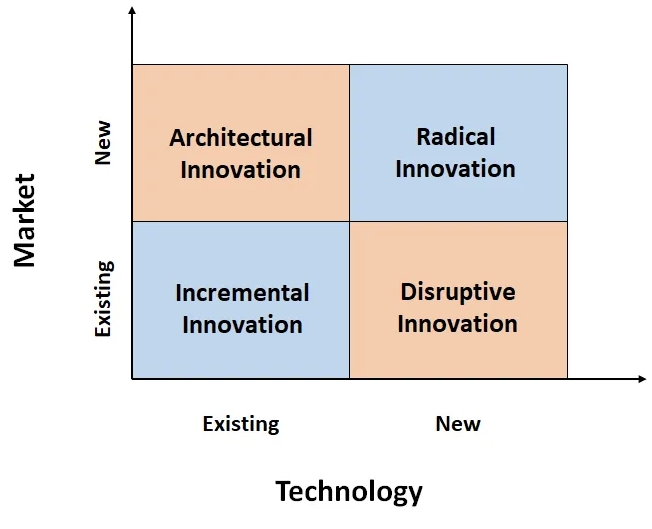
- Define the axes: market novelty on one axis and technology novelty on the other.
- Plot existing and potential innovation projects on the matrix.
- Analyze the distribution of projects to assess the balance and focus of the innovation portfolio.
- Develop strategic initiatives corresponding to each quadrant of the matrix.
- Implement plans with an understanding of the risk and novelty involved.
Time Investment
- 1-3 hours for analysis and planning
Expected Results
- A visual representation of the innovation strategy
- A balanced approach to managing different innovation initiatives
- Strategic insights into where to focus innovation efforts
Benefits
- Encourages a balanced innovation portfolio
- Helps in understanding the strategic implications of different types of innovation
- Assists in resource allocation and risk management
Limitations
- May oversimplify the complexity of innovation processes
- The matrix is static and may not capture the dynamic nature of markets and technologies
- Requires accurate and often subjective assessment of 'novelty'
Examples
- A tech company uses the Innovation Matrix to balance its investment between improving existing products and developing new technologies.
- A pharmaceutical company plots its drug development pipeline on the matrix to ensure a mix of incremental and breakthrough innovations.
Conclusion
The Innovation Matrix is an essential tool for organizations seeking to develop a structured approach to innovation. By categorizing innovation efforts, companies can strategically allocate resources, manage risk, and pursue a portfolio of projects that balance the needs for both continuous improvement and breakthrough innovation.`
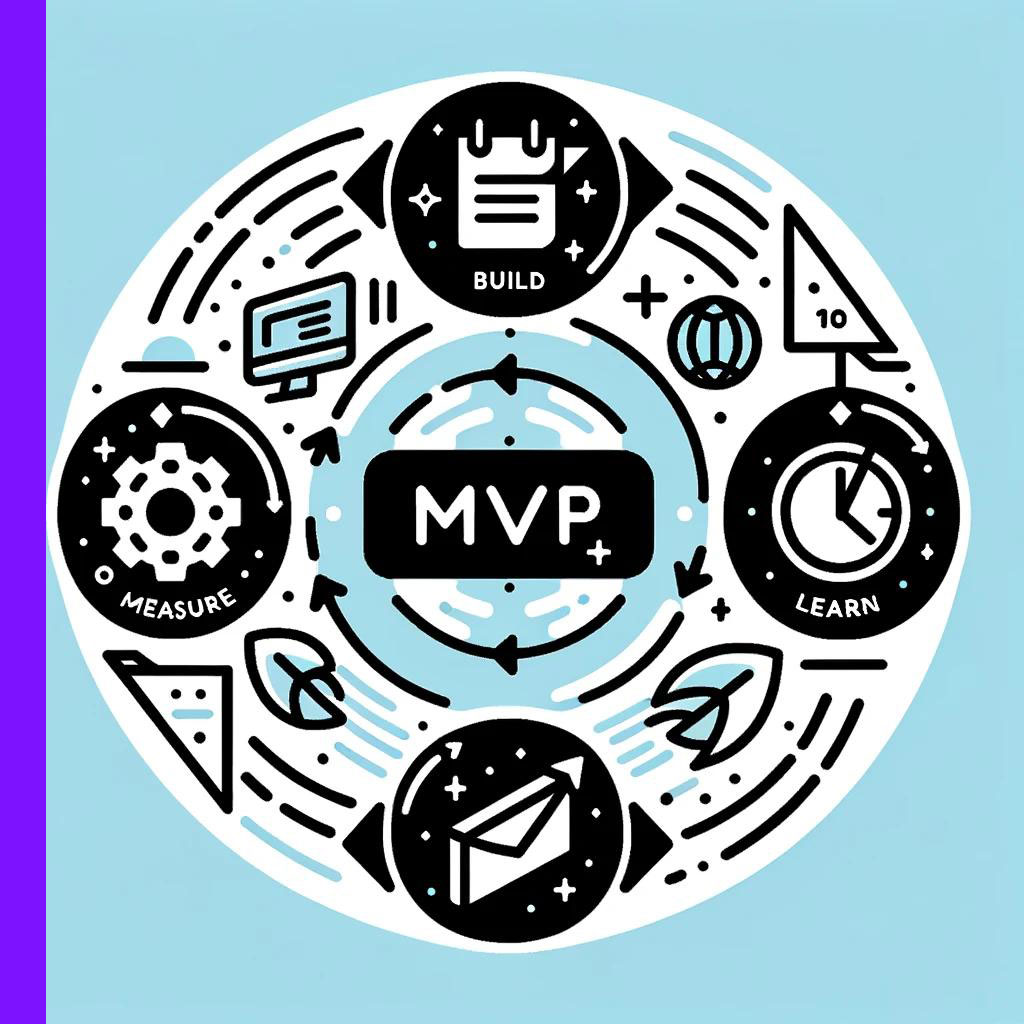
MVP and Lean Startup
Introduction to the Tool
Minimum Viable Product (MVP) and Lean Startup are closely related concepts in the world of startup development, introduced by Eric Ries. The MVP is the simplest version of a product that allows a team to collect the maximum amount of validated learning about customers with the least effort. The Lean Startup methodology is a business approach that favors experimentation overelaborate planning, customer feedback over intuition, and iterative design over traditional “big design up front” development.
Who should use it
- Startup founders
- Product managers
- Software developers
- Innovation labs
- Business school students
When to Use
- At the early stages of a new product or service development
- When validating a business idea
- For iterating and improving products based on customer feedback
- In fast-paced industries where quick adaptation is crucial
Objectives
- To quickly test and validate hypotheses about a business model
- To reduce waste by developing only what is necessary
- To accelerate learning through build-measure-learn feedback loops
How to Use It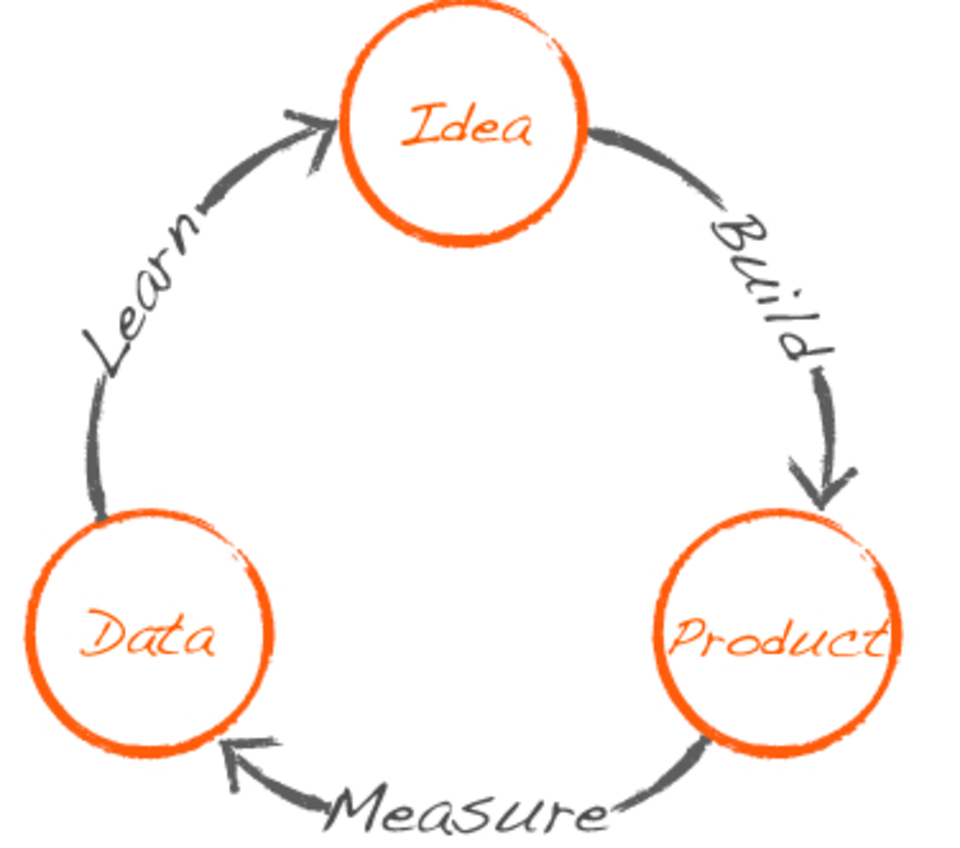
- Identify the core problem your product is solving.
- Define the minimum set of features needed to solve that problem, and create an MVP.
- Measure the MVP’s effectiveness in the market through customer interactions.
- Learn from the feedback and iterate on the product accordingly.
- Repeat the process, refining the business model and product each cycle.
Time Investment
- Varies greatly; could be weeks to months for initial cycles
Expected Results
- A better understanding of customer needs
- A product that is more closely aligned with market demands
- Faster iteration and development cycles
Benefits
- Minimizes time and resources spent on non-viable product features
- Helps to find a product-market fit more efficiently
- Encourages innovation and flexibility
Limitations
- May result in a less polished initial product
- Can be challenging to determine the true “minimum” set of viable features
- Risk of misunderstanding customer feedback
Examples
- A tech startup develops an MVP for a new app and uses customer feedback for improvements.
- An e-commerce company applies Lean Startup principles to test a new market strategy with a small investment before rolling it out broadly.
Conclusion
The MVP and Lean Startup approach is a powerful combination for any organization looking to innovate rapidly and efficiently. This method allows for real-world testing and learning, which is invaluable for aligning a product with the needs of its users. While it requires a culture comfortable with rapid iteration and occasional failure, the benefits of building a product that customers truly want can be immense.
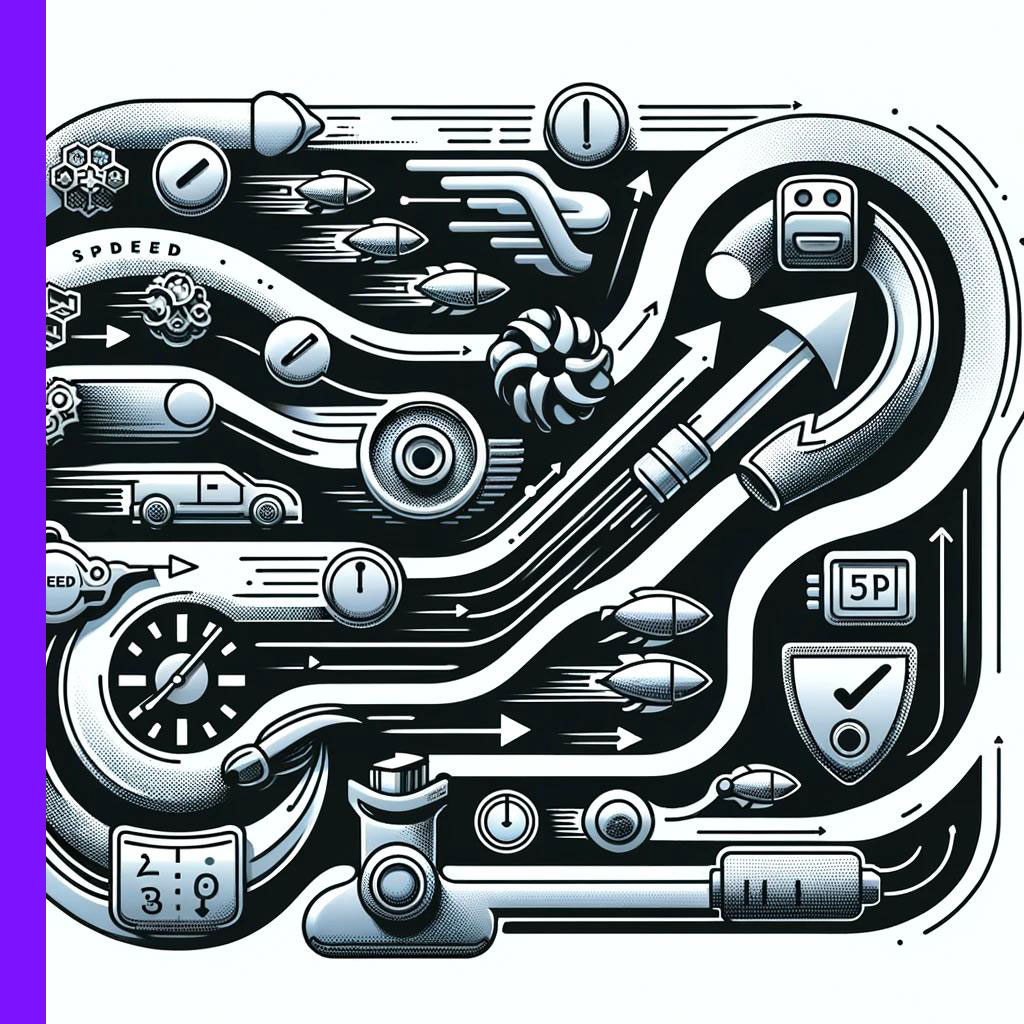
Rapid Prototyping
Introduction to the Tool
Rapid Prototyping is an iterative approach to the development of prototypes that allows teams to quickly create and evolve product models. This method is used to visualize and test the form, fit, and function of a design before final production, saving time and resources.
Who should use it
- Product designers
- Engineers
- Software developers
- User experience (UX) designers
- Innovators and inventors
When to Use
- In the early stages of product development
- When needing to test the feasibility of a design
- Before investing in full-scale production
- To quickly gather user feedback on a concept
Objectives
- To validate design concepts swiftly
- To identify design flaws early in the development process
- To incorporate user feedback rapidly into the design
- To accelerate the product development cycle
How to Use It
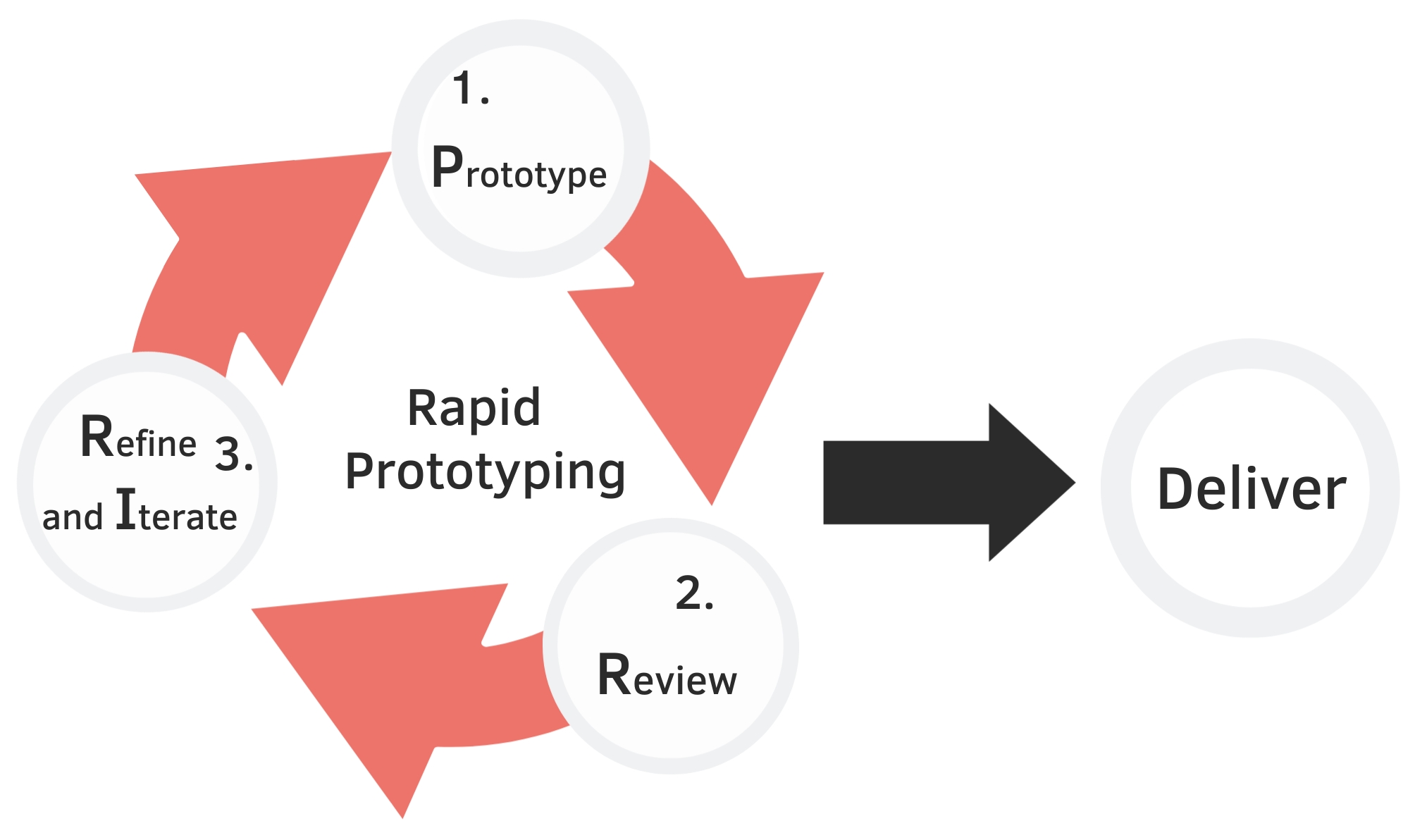
- Define the basic requirements and scope of the prototype.
- Choose a prototyping method suitable for the product
(3D printing, software simulation, etc.). - Develop the initial prototype based on the design concept.
- Test the prototype internally and with potential users.
- Collect feedback and refine the prototype iteratively.
- Repeat the cycle until the design meets the desired criteria
Time Investment
- Varies greatly; from a few hours to several weeks
Expected Results
- A series of improved prototypes based on iterative feedback
- A final design that is thoroughly tested and user-validated
- Shorter overall product development time
Benefits
- Speeds up the design process
- Enhances flexibility and adaptability in product development
- Improves the final product quality through iterative testing
Limitations
- May result in an oversimplified version of the final product
- The prototype may not always accurately represent the final functionality
- Costs can add up if many iterations are needed
Examples
- A tech company quickly prototypes a new smartphone case design using 3D printing.
- A software team develops a clickable mockup of a mobile application to test user experience.
Conclusion
Rapid prototyping is a valuable tool for modern product development, allowing teams to quickly visualize and test a design before committing to production. It promotes a user-centered approach to design, reduces development time, and helps prevent costly errors. While it may have limitations, the benefits of being able to adapt and evolve a product rapidly are significant in a competitive market.
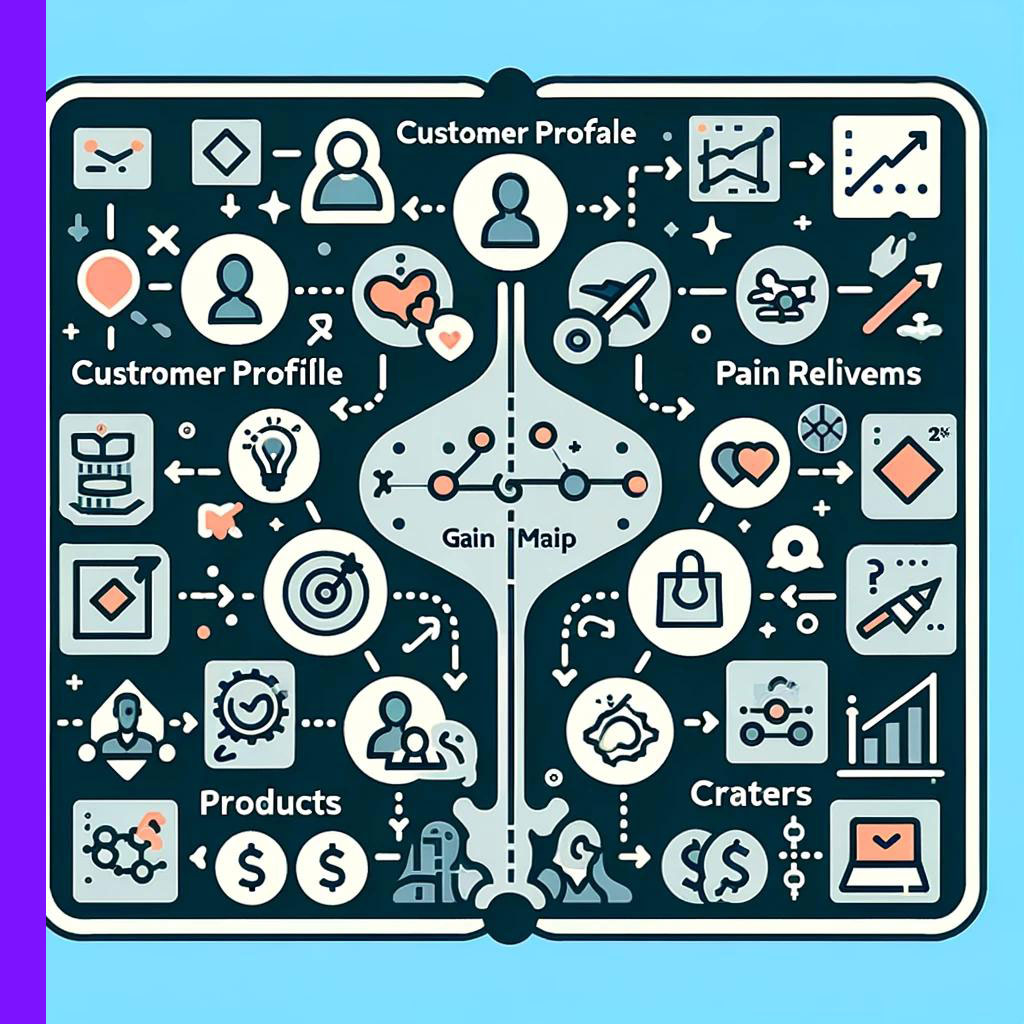
Value Proposition Canvas
Introduction to the Tool
The Value Proposition Canvas is a tool that helps businesses ensure that a product or service is positioned around what the customer values and needs. Developed by Alex Osterwalder as part of the Business Model Canvas, it breaks down the value proposition into two main components: the customer profile and the company’s value map.
Who should use it
- Entrepreneurs
- Marketing professionals
- Product managers
- Business strategists
- Design thinkers
When to Use
- During new product or service development
- When re-evaluating or redefining a business model
- To better understand customer segments and their needs
- Before a product launch or marketing campaign
Objectives
- To align a product's benefits with customer desires
- To identify customer needs and how the business can meet them
- To create a tailored value proposition that resonates with customers
How to Use It
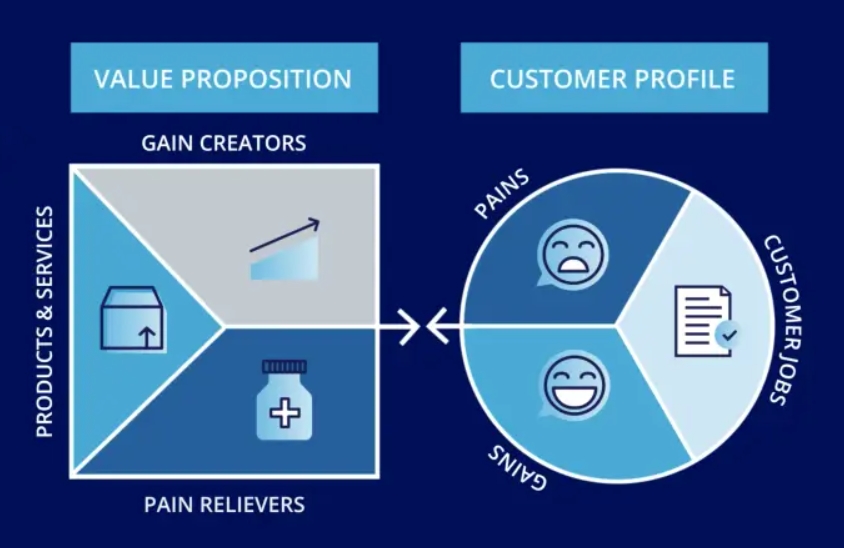
- Identify the customer segment for which the value proposition is being created.
- Map out the customer profile detailing customer jobs, pains, and gains.
- Develop the value map, listing the products and services, pain relievers, and gain creators.
- Match the components of the value map to the relevant elements of the customer profile.
- Validate the canvas through customer feedback, and refine, as necessary.
Time Investment
- 2-6 hours
Expected Results
- A well-defined customer profile
- A clear map of how the business creates value for the customer
- An articulated and compelling value proposition
Benefits
- Clarifies the strategic fit between the customer’s needs and the company’s offer
- Enhances focus on the customer in product and service design
- Facilitates clear communication of the value proposition to customers
Limitations
- May require substantial customer research to complete accurately
- Can be challenging to distill complex customer profiles and value maps
- Assumes a level of customer awareness and ability to articulate needs
Examples
- A software company uses it to refine the features of a project management tool.
- A healthcare provider employs it to design a patient-centric service model.
Conclusion
The Value Proposition Canvas is an invaluable tool for businesses seeking to ensure their offerings are not only aligned with customer needs but also clearly communicated and understood. It bridges the gap between product design and customer experience, fostering a customer-centric approach to business strategy.
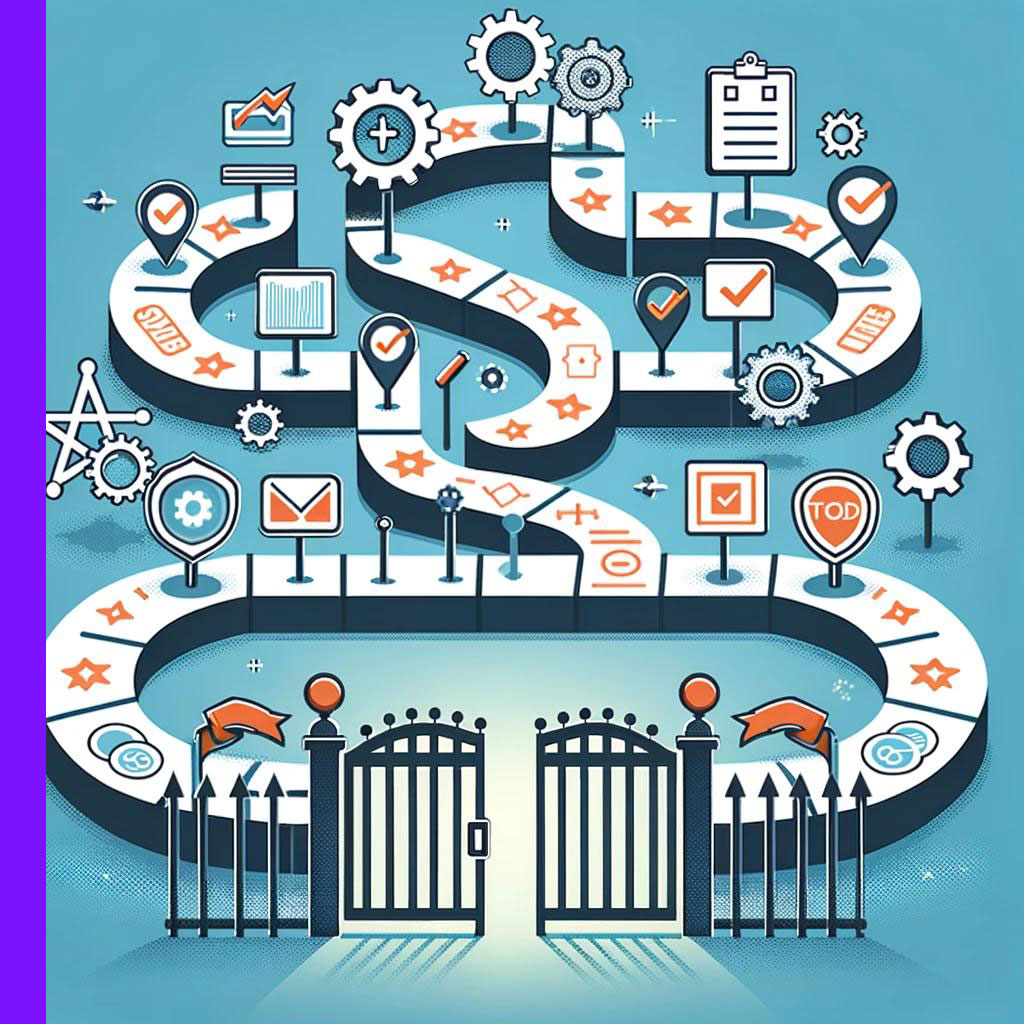
Stage-Gate Process
Introduction to the Tool
The Stage-Gate Process, also known as phase-gate process, is a project management technique that divides the process of taking a new product from concept to market into different stages, separated by gates. At each gate, the continuation of the process is decided by (typically) a manager or a steering committee. The concept was developed by Dr. Robert G. Cooper, as a means to manage the risks involved in innovation.
Who should use it
- Product managers
- Project teams in R&D
- Innovation managers
- Cross-functional product development teams
- Business executives
When to Use
- When developing new products
- In the process of bringing a technological innovation to market
- For managing complex projects with significant risks
- During portfolio management for new product development
Objectives
- To improve the success rate of new products
- To identify and mitigate risks early in the product development process
- To ensure resources are allocated to the most promising projects
- To provide a structured approach to innovation management
How to Use It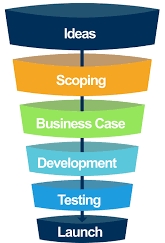
- Define the project and draft a plan.
- Break the project into stages separated by gates.
- At each stage, undertake necessary research, development, and testing activities.
- At each gate, review progress, evaluate results, and decide whether to continue, halt, or redirect the project.
- Continue through all stages and gates until the project is completed or stopped.
Time Investment
- Depends on project complexity; weeks to years
Expected Results
- A well-vetted product ready for launch
- Documented checkpoints and decision points throughout the project
- Allocation of resources to projects with the highest potential
Benefits
- Provides a clear framework for project management
- Allows for informed decision-making at key points
- Reduces the risk of costly failures
Limitations
- Can be bureaucratic and may slow down innovation
- May not be flexible enough for fast-paced industries
- Can discourage creativity if too rigidly applied
Examples
- A pharmaceutical company uses Stage-Gate to manage the development of a new drug.
- An automotive company applies the process to oversee the creation of a new electric vehicle model.
Conclusion
The Stage-Gate Process is a proven method for managing the complexities and inherent risks of new product development. It offers a disciplined approach for evaluating progress and making informed decisions, which can significantly increase the likelihood of a product’s success in the market.
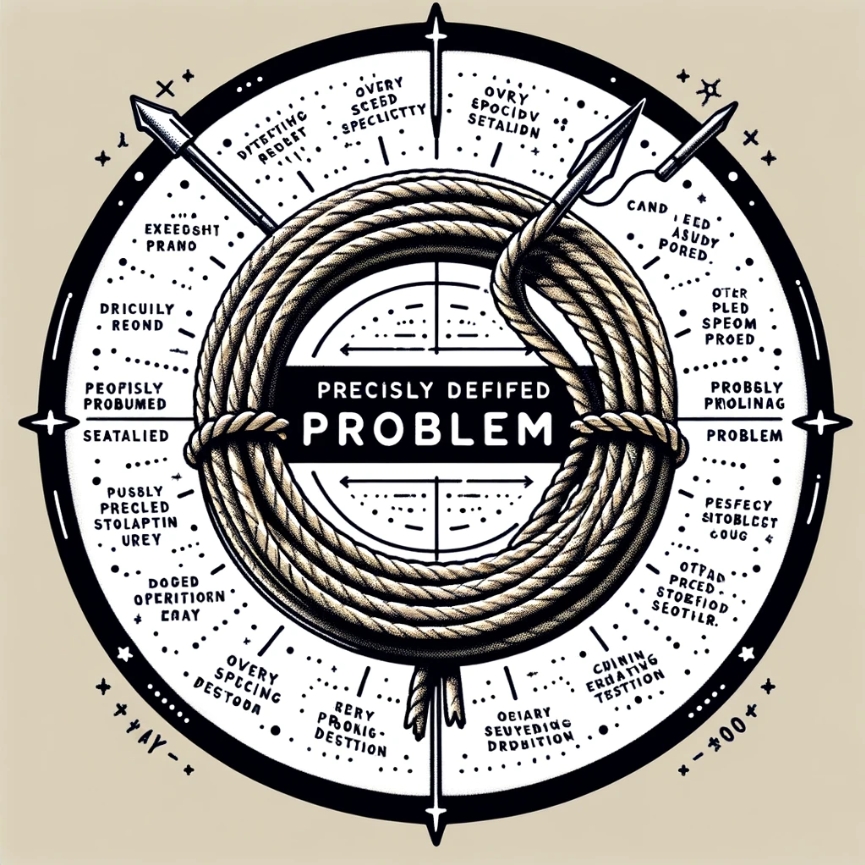
The Lasso Principle
Introduction to the Tool
The Lasso Principle is a conceptual tool that focuses on the accurate and precise definition of problems. It postulates that properly framing a problem constitutes half the solution, as it allows for the targeting of specific and feasible solutions.
Who should use it
- Problem solvers in any context
- Managers and team leaders
- IT professionals
- Process improvement specialists
- Individuals seeking to enhance their problem-solving skills
When to Use
- When initially confronting a problem
- Before brainstorming solutions
- During the problem analysis phase
- In the planning stage of project management
Objectives
- To define problems accurately without being too narrow or too broad
- To enable the identification of the most effective and efficient solutions
- To avoid unnecessary complexity in problem-solving
How to Use It
 Describe the problem in its most general form.
Describe the problem in its most general form.- Refine the problem statement to avoid overly narrow definitions that pre-empt potential solutions.
- Also avoid overly broad definitions that could lead to unnecessarily complex solutions.
- Aim for a problem definition that allows for multiple specific solution pathways.
- Test and implement solutions within time and budgetary constraints, starting with the least costly.
Note: More detailed instructions can be found here.
Time Investment
- Varies depending on the problem, often 5-10 minutes
Expected Results
- A precise problem definition
- Efficient and effective problem resolution
Benefits
- Streamlines the problem-solving process
- Prevents overinvestment in complex solutions
- Enhances the focus and relevance of potential solutions
Limitations
- Requires critical thinking and the ability to abstract from specific details
- May be challenging for those accustomed to immediately jumping to solutions
- Relies on the problem solver’s ability to balance detail and breadth
Examples
- An IT department uses the Lasso Principle to troubleshoot computer performance issues.
- A business team applies it to refine the scope of a new project initiative.
Conclusion
The Lasso Principle is a powerful aid in problem-solving that ensures issues are neither too narrowly nor too broadly defined. It encourages a balanced approach that considers multiple potential solutions, leading to more effective and economical outcomes. This principle can be applied universally, wherever precise problem definition is needed to guide successful resolution.
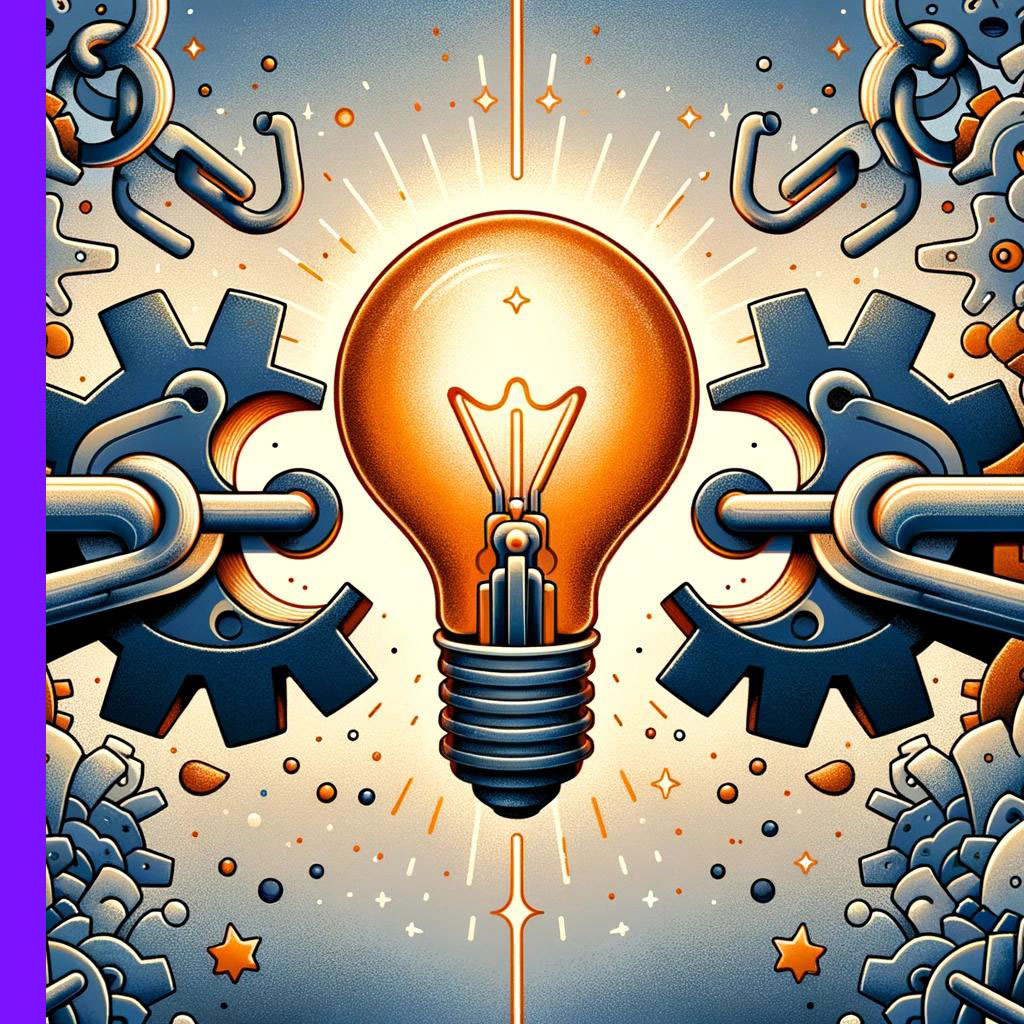
The Resolved Conflict Principle
Introduction to the Tool
The Resolved Conflict Principle is rooted in the theory of inventive problem solving, known as TRIZ, developed by Soviet engineer and researcher Genrich Altshuller. It is predicated on the notion that inventive solutions arise from the resolution of conflicts between opposing forces or constraints without compromise. TRIZ provides a systematic approach to understanding and solving these contradictions by reframing them in a way that the solution neutralizes the conflict.
Who should use it
- Engineers
- Product designers
- Innovators
- Business strategists
- Anyone involved in complex problem-solving
When to Use
- When faced with seemingly overwhelming contradictions in a project
- In the product development process to overcome design challenges
- During strategic planning to reconcile conflicting business objectives
Objectives
- To enhance the creative problem-solving process
- To identify and break through limiting assumptions in problem-solving
- To assist in finding innovative solutions that resolve conflicts without trade-offs
How to Use It
 Identify the primary contradiction or conflict in the problem.
Identify the primary contradiction or conflict in the problem.- Formulate the problem using the Resolved Conflict Principle, stating the desired outcome as if it has already been achieved despite the constraints.
Note: More detailed instructions can be found here.
How to use TRIZ to solve the (defined) problem
- Explore TRIZ principles and strategies for resolving contradictions.
- Develop inventive solutions that navigate through or around the constraints.
- Implement and test the solutions to ensure the conflict is resolved
Time Investment
- Defining the problem: 5-10 minutes usually
- Applying TRIZ to solve the problem: Hours to weeks, depending on complexity
Expected Results
- A useful definition of the problem
- Understanding the constrains
- Directions for breakthrough solutions that resolve the core conflict
- A broader range of innovative options
Benefits
- Overcomes the limitations of conventional compromise-based solutions
- Encourages a deeper understanding of the problem's fundamental nature
- Utilizes a proven methodology for innovative problem-solving
Limitations
- May be too complex for simple or straightforward problems
- Involves significant intellectual effort and creativity
- Solving the problem requires a deep understanding of TRIZ methodologies
Examples
- An automotive company uses TRIZ to design a car engine that is powerful yet fuel-efficient.
- A software firm applies TRIZ to develop a new algorithm that is both secure and fast.
Conclusion
The Resolved Conflict Principle of TRIZ is a powerful tool for innovation, particularly useful in complex scenarios where standard solutions are insufficient. By embracing contradictions as opportunities for innovation, TRIZ helps to catalyze breakthrough thinking and advance technology and business practices.

Backward Problem Solving
Introduction to the Tool
Backward Problem Solving, also known as reverse or "end-to-beginning" problem solving, is a strategy that starts by identifying the desired solution and then works backwards to determine the necessary steps to achieve that solution. It's a method that forces thinking from the future to the present.
Who should use it
- Engineers
- Educators
- Project managers
- Strategic planners
- Business leaders
When to Use
- For complex problem-solving
- When setting long-term goals
- When establishing a new business or product line
- In the early stages of project planning
Objectives
- To clearly define the end solution or goal
- To map out a step-by-step path to that solution or goal
- To anticipate potential obstacles and plan for contingencies
How to Use It

- Define the final solution or objective, with specific details and a set target date.
- Identify the last milestone before the final objective is met.
- Determine the actions required to progress beyond the last milestone.
- Continue defining earlier milestones, working backward to the current status.
- Assess potential risks and establish preventive measures.
Note: More detailed instructions can be found here.
Time Investment
- Hours to days, depending on the complexity
Expected Results
- A clear plan with defined milestones
- Preparedness for possible challenges
- Streamlined path to the desired outcome
Benefits
- Provides a clear vision of the solution or goal, which can motivate and guide planning
- Helps in identifying the most efficient order of actions
- Encourages comprehensive consideration of challenges and risks
- Motivates to find the light “at the end of the tunnel” by starting from that light
Limitations
- Can be time-consuming
- Some problems cannot be solved, and some goals cannot be reached, even not backwards
- Requires flexibility to adapt as circumstances change
Examples
- A company uses backward planning to achieve a 6 Sigma quality level in two years.
- A business sets up a European distribution center to increase foreign market sales.
Conclusion
Backward planning is a powerful tool that offers both strategic and psychological advantages by focusing on the endpoint and energizing the planning process with a clear vision of success. It's particularly beneficial for complex problems or projects where the path to the end goal isn't immediately clear.
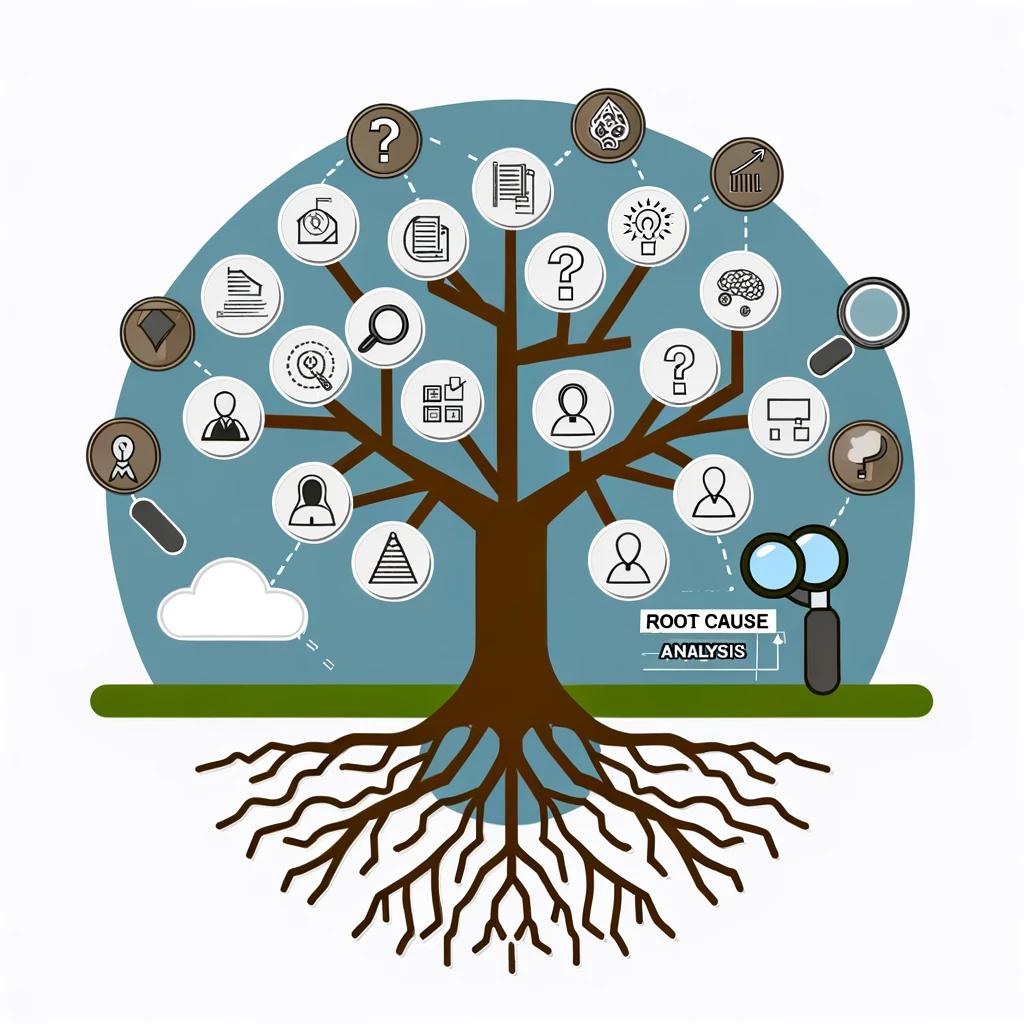
Root Cause Analysis (RCA)
Introduction to the Tool
Root Cause Analysis (RCA) is a methodical approach used to identify the underlying causes of a problem or incident. The goal is to discover the primary cause of a problem to prevent its recurrence. RCA is commonly used in the field of quality control management, but its principles are applicable across various industries and processes.
Who should use it
- Quality assurance personnel
- Operations managers
- IT professionals
- Safety officers
- Healthcare administrators
When to Use
- After a critical incident or unexpected failure has occurred
- When a problem is complex and involves multiple contributing factors
- In the aftermath of an unexpected business downturn
- For continual process improvement
Objectives
- To identify the root cause of problems or incidents
- To prevent recurrence of the issue
- To improve products, processes, and operations
- To enhance safety and reduce risks
How to Use It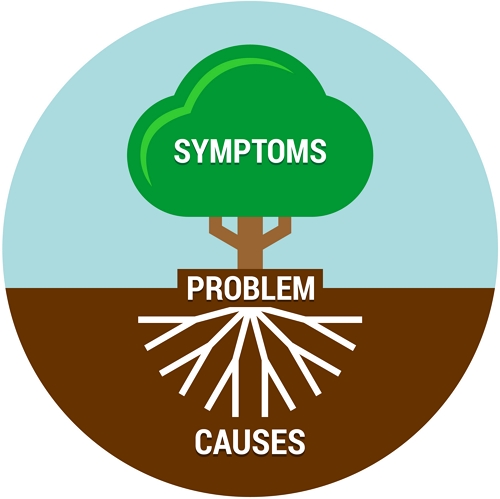
- Define the problem clearly and understand its impact.
- Gather data and evidence about the problem’s occurrence.
- Analyze the data to identify patterns and potential causes.
- Use RCA tools like the “5 Whys” or cause-and-effect diagrams to trace the problem's origins.
- Identify corrective actions to address the root cause.
- Implement the solutions and monitor for effectiveness.
Time Investment
- Varies; could be hours to days
Expected Results
- A clear understanding of why an issue occurred
- Solving the cause, not the symptoms
- Reduced likelihood of problem recurrence
Benefits
- Encourages a deeper understanding of processes
- Promotes a proactive culture of improvement and safety
- Can save resources by preventing future issues
Limitations
- Time-consuming if not focused properly
- Requires thorough data collection and analysis
- Potential for misidentification of the root cause if the analysis is superficial
Examples
- An airline conducting RCA after a safety incident to improve procedures.
- A hospital implementing RCA to reduce patient readmission rates.
Conclusion
Root Cause Analysis is a critical tool for problem-solving and quality improvement. It provides a structured approach to identifying the true causes of problems, allowing for more effective solutions. While it can be time-consuming, the potential benefits of preventing future issues and improving operational efficiency make RCA an indispensable part of organizational best practices.
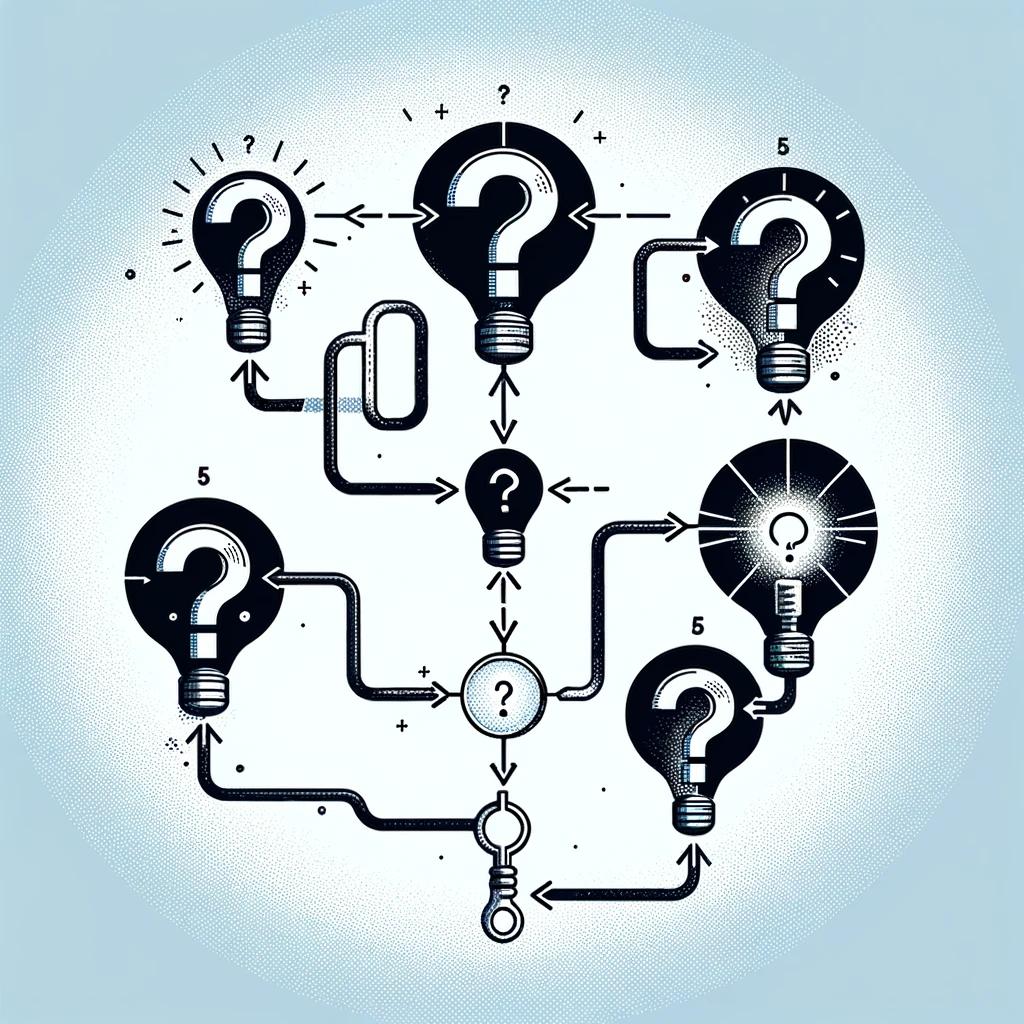
5 Whys
Introduction to the Tool
The 5 Whys is a problem-solving technique developed by Sakichi Toyoda and widely used within the Toyota Production System and lean manufacturing. It aims to explore the cause-and-effect relationships underlying a particular problem by asking the question "Why?" five times or until the root cause of the problem is identified.
Who should use it
- Business managers
- Process engineers
- Quality control teams
- Project managers
- Anyone looking to solve problems effectively
When to Use
- When a problem or issue arises that needs a clear understanding
- In continuous improvement processes
- During post-mortem or retrospective meetings
- To prevent recurrence of issues
Objectives
- To identify the root cause of a problem
- foster a deeper understanding of processes
- To implement more effective solutions
How to Use It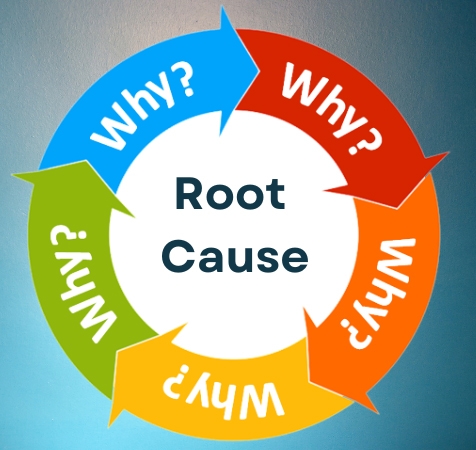
- Start with a problem, and ask "Why did this happen?" to identify an initial cause.
- Ask "Why?" again to peel another layer of the issue, repeating this process.
- Keep asking "Why?" until reaching the underlying root cause, typically by the 5th why.
- Once the root cause is identified, develop corrective actions to prevent recurrence.
- Implement the solution and monitor the results to ensure the problem is resolved.
Time Investment
- 30 minutes to several hours
Expected Results
- Identification of the root cause of a problem
- Solutions that address the fundamental issue
- Prevention of issue recurrence
Benefits
- Simple and easy to apply
- Encourages critical thinking and deeper analysis
- Can be used without specialized tools or processes
Limitations
- Risk of stopping the inquiry too soon, before the true root cause is found
- Can lead to a narrow focus, missing broader systemic issues
- Requires honest and open communication
Examples
- A manufacturing company uses the 5 Whys to determine the cause of a production line failure.
- A software team applies the 5 Whys to uncover the reasons behind a recurring bug.
Conclusion
The 5 Whys is a powerful yet simple tool for root cause analysis. By methodically questioning the cause of a problem, it helps teams to uncover the underlying issues that need to be addressed. While it has its limitations, when applied correctly, the 5 Whys can lead to significant improvements in processes and products.
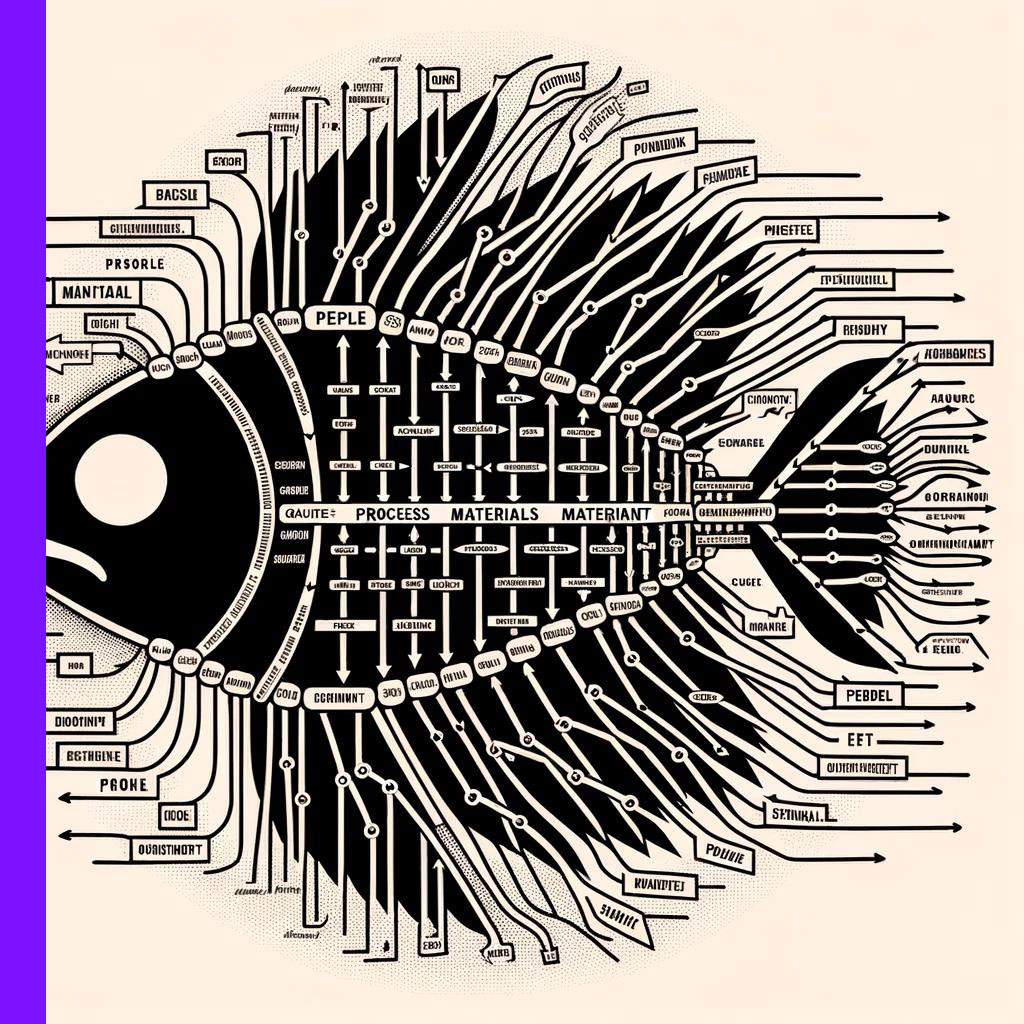
Fishbone Diagram (Ishikawa)
Introduction to the Tool
The Fishbone Diagram, also known as the Ishikawa diagram or cause-and-effect diagram, is a visual tool used to systematically identify and present the possible causes of a specific problem or effect. Developed by Kaoru Ishikawa in the 1960s, it is particularly useful in quality management and problem-solving processes.
Who should use it
- Quality control teams
- Project managers
- Process engineers
- Business analysts
- Anyone involved in problem-solving and process improvement
When to Use
- To identify potential factors causing an overall effect
- In brainstorming sessions focused on problem identification
- For analyzing the root causes of quality issues
- During the planning phase of project management
Objectives
- To visually display the potential causes of a problem
- To facilitate the identification of root causes
- To encourage team collaboration in problem-solving
- To structure brainstorming sessions effectively
How to Use It
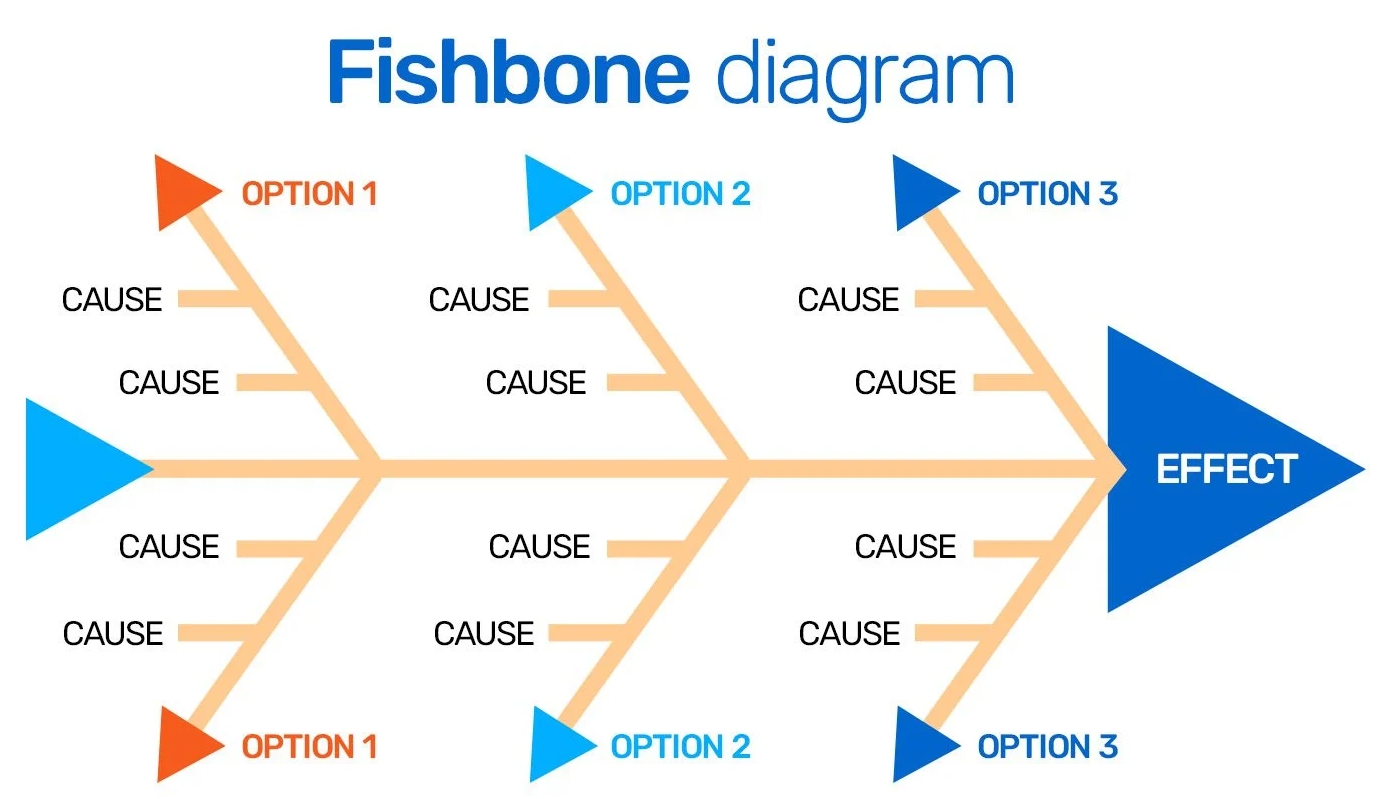
- Clearly define the problem or effect and write it at the head of the fishbone diagram.
- Draw a horizontal line from the problem to create the “spine” of the fish.
- Identify the major categories of causes and draw “bones” off the spine for each.
- Brainstorm all possible causes of the problem, adding them as smaller “bones” off the major categories.
- Analyze the diagram to identify the most likely root causes.
- Prioritize and test these causes to confirm their impact on the problem.
Time Investment
- 1-4 hours
Expected Results
- A comprehensive overview of all potential causes of a problem
- Identification of areas where data should be collected
- Enhanced understanding of the factors contributing to the issue
Benefits
- Encourages thorough analysis of problems
- Promotes a systematic approach to identifying root causes
- Facilitates communication and understanding among team members
Limitations
- Can become unwieldy with complex problems
- Requires experienced facilitation for effective use
- May not always lead directly to the root cause
Examples
- A manufacturing team uses the Fishbone Diagram to identify the causes of equipment failure.
- A customer service department applies it to analyze the reasons behind customer complaints.
Conclusion
The Fishbone Diagram is an effective tool for organizing thoughts and identifying potential causes of a problem. It helps teams to visually articulate and tackle complex issues by breaking them down into manageable parts. While it has its limitations, its benefits in promoting collaborative problem-solving and analytical thinking make it a valuable asset in various fields.
Systematic innovation
Interested in getting help with systematic innovation processes and developing new products and services?
Contact us: [email protected] ,+972-9-958-5085
Innovation Articles
- Innovation - overview
- Innovation management and process
- Innovation tools and methods
- Innovation and other disciplines
- Innovation in organizations
- Innovation importance and goals
- Innovation values and inspiration
- Innovation education and career
- Product and service innovation
- Technological innovation
- Innovation examples
- Innovation terms (glossary)





